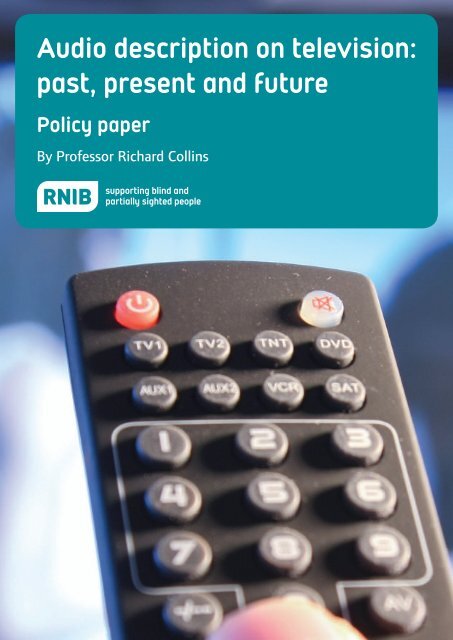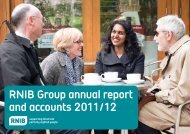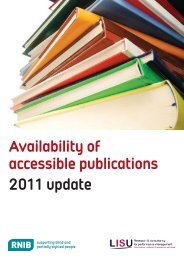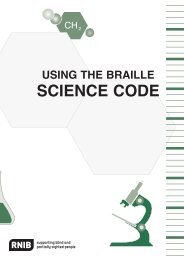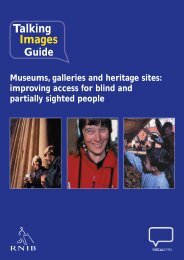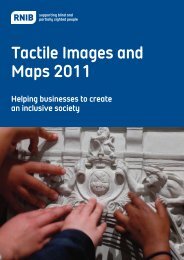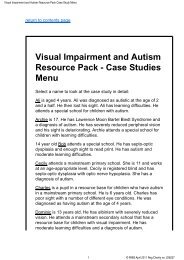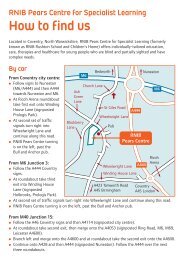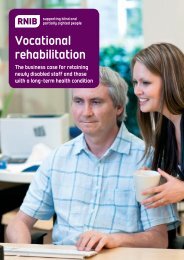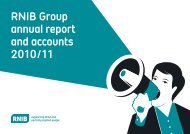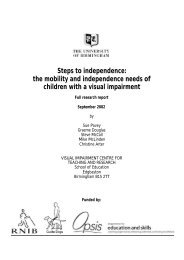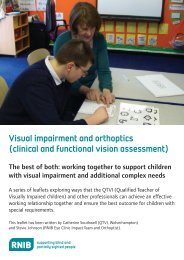Audio description on television: past, present and future. RNIB policy ...
Audio description on television: past, present and future. RNIB policy ...
Audio description on television: past, present and future. RNIB policy ...
Create successful ePaper yourself
Turn your PDF publications into a flip-book with our unique Google optimized e-Paper software.
<str<strong>on</strong>g>Audio</str<strong>on</strong>g> <str<strong>on</strong>g>descripti<strong>on</strong></str<strong>on</strong>g> <strong>on</strong> televisi<strong>on</strong>:<br />
<strong>past</strong>, <strong>present</strong> <strong>and</strong> <strong>future</strong><br />
Policy paper<br />
By Professor Richard Collins
Logo – <strong>RNIB</strong> supporting blind <strong>and</strong> partially sighted people<br />
Registered charity number 226227<br />
<str<strong>on</strong>g>Audio</str<strong>on</strong>g> <str<strong>on</strong>g>descripti<strong>on</strong></str<strong>on</strong>g> <strong>on</strong> televisi<strong>on</strong>:<br />
<strong>past</strong>, <strong>present</strong> <strong>and</strong> <strong>future</strong><br />
Policy paper<br />
By Professor Richard Collins
This <strong>policy</strong> paper was written by Professor Richard Collins, Visiting Professor<br />
in the Centre for Law, Justice <strong>and</strong> Journalism at City University, L<strong>on</strong>d<strong>on</strong> in<br />
May 2012 for <strong>RNIB</strong>. This paper c<strong>on</strong>tains <strong>policy</strong> recommendati<strong>on</strong>s from the<br />
named author.<br />
Royal Nati<strong>on</strong>al Institute of Blind People<br />
105 Judd Street<br />
L<strong>on</strong>d<strong>on</strong> WC1H 9NE<br />
ISBN 978 1 4445 0113 1<br />
© <strong>RNIB</strong>, 2012<br />
Registered charity number 226227<br />
rnib.org.uk<br />
1
C<strong>on</strong>tents<br />
Introducti<strong>on</strong> ................................................................................................... 3<br />
1. Development of audio <str<strong>on</strong>g>descripti<strong>on</strong></str<strong>on</strong>g> <strong>on</strong> UK televisi<strong>on</strong> ................................. 4<br />
1.1. Current regulati<strong>on</strong> <strong>and</strong> implementati<strong>on</strong> .............................................. 4<br />
1.2. Historical development of audio <str<strong>on</strong>g>descripti<strong>on</strong></str<strong>on</strong>g> in the UK ...................... 8<br />
1.3. Overseas experience ....................................................................... 14<br />
2. The Challenge of Video <strong>on</strong> Dem<strong>and</strong> (VoD) ............................................ 16<br />
2.1. The state of VoD .............................................................................. 16<br />
2.2. The current regulati<strong>on</strong> <strong>and</strong> access services <strong>on</strong> VoD ....................... 17<br />
3. Future regulati<strong>on</strong> of access services ...................................................... 20<br />
3.1. The need for a new regulatory framework to regulate access<br />
services for VoD ..................................................................................... 20<br />
3.2. Future regulati<strong>on</strong> of provisi<strong>on</strong> of audio described programmes <strong>on</strong><br />
linear televisi<strong>on</strong> ....................................................................................... 23<br />
C<strong>on</strong>clusi<strong>on</strong> .................................................................................................. 24<br />
Acknowledgements .................................................................................... 26<br />
References ................................................................................................. 26<br />
About the author ......................................................................................... 30<br />
Footnotes ................................................................................................... 31<br />
rnib.org.uk<br />
2
Introducti<strong>on</strong><br />
<str<strong>on</strong>g>Audio</str<strong>on</strong>g> <str<strong>on</strong>g>descripti<strong>on</strong></str<strong>on</strong>g> of televisi<strong>on</strong> programmes helps blind <strong>and</strong> partially sighted<br />
people share experiences which sighted people take for granted.<br />
Comprehensive <strong>and</strong> effective audio <str<strong>on</strong>g>descripti<strong>on</strong></str<strong>on</strong>g> is vital if blind <strong>and</strong> partially<br />
sighted people are to share experiences which sighted people take for<br />
granted. Ofcom defines audio <str<strong>on</strong>g>descripti<strong>on</strong></str<strong>on</strong>g> (AD) as, “a separate audio track in<br />
which a narrator uses gaps in the original soundtrack to describe what is<br />
happening for the benefit of people with visual impairments (c2 per cent of the<br />
European populati<strong>on</strong>); like subtitling, the service can be turned <strong>on</strong> or off”<br />
(Ofcom 2010: 5).<br />
<str<strong>on</strong>g>Audio</str<strong>on</strong>g> <str<strong>on</strong>g>descripti<strong>on</strong></str<strong>on</strong>g> in the UK is available <strong>on</strong>ly <strong>on</strong> digital TV which, by the end of<br />
2012, will be in all UK TV households (after the completi<strong>on</strong> of analogue<br />
televisi<strong>on</strong> switch off/digital switchover). New initiatives to assist blind <strong>and</strong><br />
partially sighted people's access to televisi<strong>on</strong> services c<strong>on</strong>tinue to be<br />
developed: notably Text-to-Speech (TTS) applicati<strong>on</strong>s (eg <strong>RNIB</strong>’s 1 Smart<br />
Talk box <strong>and</strong> Panas<strong>on</strong>ic’s 2012 range of televisi<strong>on</strong>s). These improve access<br />
by providing a spoken interface as an alternative to visual menus <strong>and</strong><br />
informati<strong>on</strong> – particularly programme listings <strong>and</strong> programme informati<strong>on</strong><br />
such as Electr<strong>on</strong>ic Programme Guide (EPG) data <strong>and</strong> spoken subtitles (see<br />
DTV4All 2011 <strong>and</strong> Looms passim). 2<br />
Please note that footnotes appear at the end of this document.<br />
rnib.org.uk<br />
3
1. Development of audio <str<strong>on</strong>g>descripti<strong>on</strong></str<strong>on</strong>g> <strong>on</strong> UK televisi<strong>on</strong><br />
1.1. Current regulati<strong>on</strong> <strong>and</strong> implementati<strong>on</strong><br />
<str<strong>on</strong>g>Audio</str<strong>on</strong>g> <str<strong>on</strong>g>descripti<strong>on</strong></str<strong>on</strong>g> of a proporti<strong>on</strong> of broadcast televisi<strong>on</strong> programmes was<br />
first m<strong>and</strong>ated in the 1996 Broadcasting Act which looked forward to, <strong>and</strong><br />
paved the way for, digital televisi<strong>on</strong>. The act, in Secti<strong>on</strong> 20, required audio<br />
<str<strong>on</strong>g>descripti<strong>on</strong></str<strong>on</strong>g> of 10 per cent of all programmes screened, not later than the<br />
tenth anniversary of the relevant date for each channel. These provisi<strong>on</strong>s<br />
were carried forward into the Communicati<strong>on</strong>s Act 2003 (secti<strong>on</strong>s 303-308)<br />
which also m<strong>and</strong>ated Ofcom to publish a Code <strong>on</strong> Televisi<strong>on</strong> Access<br />
Services including audio <str<strong>on</strong>g>descripti<strong>on</strong></str<strong>on</strong>g> <strong>and</strong> subtitling <strong>and</strong> signing. Broadly, two<br />
models are used in the UK to deliver audio <str<strong>on</strong>g>descripti<strong>on</strong></str<strong>on</strong>g>: broadcast-mix <strong>and</strong><br />
receiver-mix. The latter requires less b<strong>and</strong>width (<strong>and</strong> thus less spectrum,<br />
thereby reducing the broadcasters’ costs) <strong>and</strong> offers users extra flexibility<br />
(notably the ability to c<strong>on</strong>trol the volume of the audio <str<strong>on</strong>g>descripti<strong>on</strong></str<strong>on</strong>g><br />
independently of the original soundtrack).<br />
Ofcom’s Televisi<strong>on</strong> Access Services Code was first published in 2004 <strong>and</strong><br />
Ofcom regularly reviews the state of access services (most recently in 2012).<br />
The Code follows the Act’s access services prescripti<strong>on</strong>s: ie 10 per cent of all<br />
programmes broadcast <strong>on</strong> qualifying channels 3 must be audio described; 80<br />
per cent must be subtitled <strong>and</strong> 5 per cent signed not later than the tenth<br />
anniversary of the relevant date (usually first licensing) for each channel. This<br />
Ofcom Code applies <strong>on</strong>ly to linear broadcast TV (ie not to EPGs 4 , “red butt<strong>on</strong>”<br />
or Video <strong>on</strong> Dem<strong>and</strong> services) <strong>and</strong> counts repeats as qualifying programmes<br />
against the 10 per cent quota.<br />
Ofcom additi<strong>on</strong>ally capped channels’ funding liability for access services at 1<br />
per cent of relevant turnover – though broadcasters are required to do as<br />
much as they can within this funding envelope. Televisi<strong>on</strong> channels directed<br />
to audiences outside the UK are exempted from access services<br />
requirements (though encouraged, as Ofcom is required to do under the EU<br />
<str<strong>on</strong>g>Audio</str<strong>on</strong>g>visual Media Services Directive, to provide them) as are those services<br />
which have a viewing share of less than 0.05 per cent.<br />
In 2012, 69 channels were required to provide audio <str<strong>on</strong>g>descripti<strong>on</strong></str<strong>on</strong>g> <strong>and</strong> these<br />
channels account for over 90 per cent of UK televisi<strong>on</strong> viewing (Ofcom 2011:<br />
1) 5 . To further improve blind <strong>and</strong> partially sighted people’s access to<br />
televisi<strong>on</strong>, <strong>RNIB</strong> asked that broadcasters audio describe 20 per cent of their<br />
c<strong>on</strong>tent. The BBC, ITV, Channel 4 <strong>and</strong> Sky have undertaken to exceed their<br />
formal targets <strong>and</strong> audio describe at least 20 per cent of programming (with<br />
rnib.org.uk<br />
4
some excepti<strong>on</strong>s – eg Sky Sports channels) (Ofcom 2011: 1). <str<strong>on</strong>g>Audio</str<strong>on</strong>g><br />
<str<strong>on</strong>g>descripti<strong>on</strong></str<strong>on</strong>g> is available in the Welsh language <strong>on</strong> S4C 6 . Ofcom’s most recent<br />
report (for 2011) <strong>on</strong> provisi<strong>on</strong> of televisi<strong>on</strong> access services (subtitling, audio<br />
<str<strong>on</strong>g>descripti<strong>on</strong></str<strong>on</strong>g> <strong>and</strong> signing), <strong>on</strong> the 70 channels where access service<br />
obligati<strong>on</strong>s apply, show that some channels significantly exceed the statutory<br />
audio <str<strong>on</strong>g>descripti<strong>on</strong></str<strong>on</strong>g> norm (the figure below shows data <strong>on</strong>ly for the top 48<br />
channels identified).<br />
UK audio <str<strong>on</strong>g>descripti<strong>on</strong></str<strong>on</strong>g> obligati<strong>on</strong>s <strong>and</strong> delivery<br />
Adapted from Ofcom 2012<br />
Service<br />
<str<strong>on</strong>g>Audio</str<strong>on</strong>g> <str<strong>on</strong>g>descripti<strong>on</strong></str<strong>on</strong>g><br />
Annual quota Achieved (Q3 & 4)<br />
BBC1 10% 15.01%<br />
BBC2 10% 14.58%<br />
BBC3 10% 25.15%<br />
BBC4 10% 28.94%<br />
BBC News 24<br />
Exempt<br />
CBBC 10% 24.32%<br />
CBeebies 10% 19.85%<br />
BBC HD 6.17% 24.15%<br />
ITV 1 10% 20.09%<br />
GMTV1 10% 13.80%<br />
ITV 2 10% 29.52%<br />
ITV 3 10% 27.12%<br />
ITV 4 10% 35.86%<br />
CITV 10% 30.35%<br />
Channel 4 10% 24.46%<br />
E4 10% 34.53%<br />
rnib.org.uk<br />
5
More 4 10% 25.04%<br />
Film 4 10% 25.14%<br />
S4C 10% 11.13%<br />
Channel 5 10% 11.57%<br />
5* 8.5% 14.47%<br />
5 USA 8.5% 15.67%<br />
Sky News<br />
Exempt<br />
Sky One 10% 27.92%<br />
Sky Two 10% 29.01%<br />
Pick TV 10% 32.94%<br />
Sky Sports 1 10% 11.74%<br />
Sky Sports 2 10% 11.10%<br />
Sky Sports 3 10% 14.57%<br />
Sky Sports 4 10% 22.96%<br />
Sky Sports News<br />
Exempt<br />
Sky Movies Acti<strong>on</strong>/Adventure 10% 36.65%<br />
Sky Movies Classics 10% 22.64%<br />
Sky Movies Comedy 10% 38.44%<br />
Sky Movies Drama/Rom 10% 35.16%<br />
Sky Movies Family 10% 38.15%<br />
Sky Movies Modern Greats 10% 24.01%<br />
Sky Movies SciFi/Horror 10% 35.87%<br />
Sky Movies Premiere 10% 38.92%<br />
Sky Showcase 6% 47.97%<br />
rnib.org.uk<br />
6
Sky Thriller 6% 26.86%<br />
Dave 10% 38.27%<br />
Blighty 10% 37.48%<br />
UKTV Food 10% 25.97%<br />
Eden 10% 38.87%<br />
Yesterday 10% 20.59%<br />
Alibi 10% 22.35%<br />
G.O.L.D. 10% 31.29%<br />
Ofcom has estimated the average cost per hour of audio <str<strong>on</strong>g>descripti<strong>on</strong></str<strong>on</strong>g> to be (in<br />
2009) £443 (Ofcom 2009: 19). The major work elements (<strong>and</strong> costs) include<br />
time spent in preparati<strong>on</strong> (normally, 2 or 3 previews are required); creating<br />
the audio <str<strong>on</strong>g>descripti<strong>on</strong></str<strong>on</strong>g> script; voicing the <str<strong>on</strong>g>descripti<strong>on</strong></str<strong>on</strong>g>; transporting the audio<br />
files to the broadcaster <strong>and</strong> integrating the audio <str<strong>on</strong>g>descripti<strong>on</strong></str<strong>on</strong>g> into the original<br />
programme. An interviewee estimated that an hour’s audio <str<strong>on</strong>g>descripti<strong>on</strong></str<strong>on</strong>g> took a<br />
day’s work (an estimate that is compatible with Ofcom’s m<strong>on</strong>etary reck<strong>on</strong>ing)<br />
<strong>and</strong> estimated that the BBC spends in the order of c£25m per annum <strong>on</strong><br />
audio <str<strong>on</strong>g>descripti<strong>on</strong></str<strong>on</strong>g>.<br />
The switchover from analogue to digital terrestrial televisi<strong>on</strong> meant that there<br />
was no technological obstacle to broadcasters providing audio <str<strong>on</strong>g>descripti<strong>on</strong></str<strong>on</strong>g><br />
enabled services but not all digital televisi<strong>on</strong> receivers have the capability to<br />
receive audio <str<strong>on</strong>g>descripti<strong>on</strong></str<strong>on</strong>g>. An audio <str<strong>on</strong>g>descripti<strong>on</strong></str<strong>on</strong>g> capability was not made<br />
m<strong>and</strong>atory for st<strong>and</strong>ard definiti<strong>on</strong> (SD) Freeview receivers 7 (though many<br />
provide it 8 ) but audio <str<strong>on</strong>g>descripti<strong>on</strong></str<strong>on</strong>g> capability is m<strong>and</strong>atory for Freeview high<br />
definiti<strong>on</strong> (HD) receivers (<strong>and</strong> also for Freesat receivers).<br />
However, despite most UK digital households recently having gained the<br />
capability to use audio <str<strong>on</strong>g>descripti<strong>on</strong></str<strong>on</strong>g> services, awareness of the service is still<br />
relatively low am<strong>on</strong>g the blind <strong>and</strong> partially sighted people for whom the<br />
service is designed. In 2009, Ofcom (2009a) found that <strong>on</strong>ly half of UK<br />
visually impaired people were aware of audio <str<strong>on</strong>g>descripti<strong>on</strong></str<strong>on</strong>g> services (though<br />
more than 60 per cent of those with severe visual impairment were aware of<br />
them). The Ofcom Televisi<strong>on</strong> Access Services Code (Ofcom 2010b) requires<br />
rnib.org.uk<br />
7
oadcasters to promote the service. Accordingly, in 2012, a four week<br />
promoti<strong>on</strong> of audio <str<strong>on</strong>g>descripti<strong>on</strong></str<strong>on</strong>g> by way of TV advertisements took place, fully<br />
funded by the broadcasters required to provide audio <str<strong>on</strong>g>descripti<strong>on</strong></str<strong>on</strong>g>. The<br />
awareness raising effort led to 54,467 views, of which 41,625 were unique<br />
page views, <strong>on</strong> the <strong>RNIB</strong> audio <str<strong>on</strong>g>descripti<strong>on</strong></str<strong>on</strong>g> web pages which were identified<br />
as a central informati<strong>on</strong> resource for people who saw the advertisements <strong>and</strong><br />
wanted to find out more.<br />
The Equality Act 2010 (replacing the Disability Discriminati<strong>on</strong> Act 1995) has<br />
requirements (see Chapter 2 Secti<strong>on</strong> 20) relevant to the provisi<strong>on</strong> of<br />
televisi<strong>on</strong> access services (including audio <str<strong>on</strong>g>descripti<strong>on</strong></str<strong>on</strong>g>). The Equality Act<br />
defines a general duty of making “reas<strong>on</strong>able adjustments” to ensure that<br />
disabled people are not substantially disadvantaged. The UK Equality Act<br />
2010 thus imposes wider obligati<strong>on</strong>s than does the Communicati<strong>on</strong>s Act 2003<br />
(extending to services such as Internet Protocol Televisi<strong>on</strong> [IPTV], <strong>and</strong> Video<br />
<strong>on</strong> Dem<strong>and</strong> [VOD]) though these obligati<strong>on</strong>s have yet to be tested in court.<br />
Though the Communicati<strong>on</strong>s Act 2003 refers specifically, <strong>and</strong> <strong>on</strong>ly, to linear<br />
broadcast televisi<strong>on</strong>, the European Uni<strong>on</strong> <str<strong>on</strong>g>Audio</str<strong>on</strong>g>visual Media Services<br />
Directive 9 of 2010 places a duty <strong>on</strong> Member States to encourage media<br />
service providers (ie not just linear televisi<strong>on</strong> broadcasters) to provide access<br />
services, including audio <str<strong>on</strong>g>descripti<strong>on</strong></str<strong>on</strong>g>. However, this provisi<strong>on</strong> (at Article 7)<br />
specifies that such services need <strong>on</strong>ly be made available “gradually”.<br />
1.2. Historical development of audio <str<strong>on</strong>g>descripti<strong>on</strong></str<strong>on</strong>g> in the UK<br />
From 1991 to 1995, <strong>RNIB</strong> participated in research (funded by the European<br />
Uni<strong>on</strong> <strong>and</strong> with the collaborati<strong>on</strong> of the BBC, ITC <strong>and</strong> ITV) <strong>on</strong> AUDETEL, an<br />
experimental analogue audio <str<strong>on</strong>g>descripti<strong>on</strong></str<strong>on</strong>g> service, which, in 1994,<br />
implemented a successful test service (for 100 blind <strong>and</strong> partially sighted<br />
people) proving the technical feasibility of TV audio <str<strong>on</strong>g>descripti<strong>on</strong></str<strong>on</strong>g> <strong>and</strong><br />
dem<strong>on</strong>strating its value to blind <strong>and</strong> partially sighted people.<br />
The AUDETEL research showed that (at a particular price point) more than<br />
half of the blind <strong>and</strong> partially sighted research subjects would pay for <strong>and</strong> use<br />
an audio <str<strong>on</strong>g>descripti<strong>on</strong></str<strong>on</strong>g> service which provided 10 hours of audio described<br />
televisi<strong>on</strong> a week. And in 2003, <strong>RNIB</strong> took delivery of a further research study<br />
(commissi<strong>on</strong>ed jointly by <strong>RNIB</strong>, the BBC, ITV <strong>and</strong> Channel 4) by Taylor<br />
Nels<strong>on</strong> Sofres Media <strong>on</strong> willingness to pay for audio <str<strong>on</strong>g>descripti<strong>on</strong></str<strong>on</strong>g>. 10 At a price<br />
point of £170, Taylor Nels<strong>on</strong> Sofres Media found that 59 per cent of<br />
resp<strong>on</strong>dents would be likely to buy (suggesting an achievable market size of<br />
105,000 units of audio <str<strong>on</strong>g>descripti<strong>on</strong></str<strong>on</strong>g> capable hardware). Research, which <strong>RNIB</strong><br />
rnib.org.uk<br />
8
had either initiated or had been an active participant in, had thus established<br />
both the technical feasibility of audio <str<strong>on</strong>g>descripti<strong>on</strong></str<strong>on</strong>g> (quickly dem<strong>on</strong>strated in<br />
practice by Sky’s introducti<strong>on</strong> of audio described digital services) <strong>and</strong> that a<br />
sizeable market existed for audio <str<strong>on</strong>g>descripti<strong>on</strong></str<strong>on</strong>g> enabled receivers priced at a<br />
level at which manufacturers could profitably meet dem<strong>and</strong>.<br />
<strong>RNIB</strong>’s AUDETEL research was undertaken within an analogue televisi<strong>on</strong><br />
framework. However, digital televisi<strong>on</strong> has been planned to provide audio<br />
<str<strong>on</strong>g>descripti<strong>on</strong></str<strong>on</strong>g> readily, <strong>and</strong> more ec<strong>on</strong>omically, than did, <strong>and</strong> does, analogue<br />
televisi<strong>on</strong>. As <strong>policy</strong> <strong>and</strong> practice shifted towards digitising the UK’s terrestrial<br />
televisi<strong>on</strong> networks, <strong>RNIB</strong> lobbied government, hardware manufacturers <strong>and</strong><br />
broadcasters to implement digital audio <str<strong>on</strong>g>descripti<strong>on</strong></str<strong>on</strong>g> services. But, when digital<br />
terrestrial televisi<strong>on</strong> (DTT) was first introduced to the UK in 1999, receiving<br />
equipment generally did not have audio <str<strong>on</strong>g>descripti<strong>on</strong></str<strong>on</strong>g> recepti<strong>on</strong> capability built<br />
in. However, by 2000 between 2 per cent <strong>and</strong> 4 per cent (depending <strong>on</strong><br />
broadcaster) of DTT programmes were audio described (though, in general,<br />
terrestrial viewers could not receive them until 2003) <strong>and</strong> by 2001 Sky’s<br />
digital satellite services had begun to provide audio <str<strong>on</strong>g>descripti<strong>on</strong></str<strong>on</strong>g> for some<br />
programmes, initially, <strong>on</strong> six channels. The (later aborted) ITV digital service<br />
also experimented with audio <str<strong>on</strong>g>descripti<strong>on</strong></str<strong>on</strong>g> capable Set Top Boxes (STBs).<br />
Accordingly, <strong>RNIB</strong> began a campaign to ensure realisati<strong>on</strong> of the potential of<br />
digital televisi<strong>on</strong> to provide audio <str<strong>on</strong>g>descripti<strong>on</strong></str<strong>on</strong>g>. It established a campaign<br />
planning group in 2000 <strong>and</strong> by autumn 2001 active campaigning was under<br />
way as Government <strong>and</strong> Parliament progressed what became the<br />
Communicati<strong>on</strong>s Act 2003 <strong>and</strong> as the first UK digital terrestrial televisi<strong>on</strong> trials<br />
began. Campaigning was led by Caroline Ellis (then <strong>RNIB</strong>'s Parliamentary<br />
Manager) 11 <strong>and</strong> Denise Evans (then <strong>RNIB</strong>'s Head of Broadcasting <strong>and</strong><br />
Talking Images), in parallel with a European level campaign led by Leen<br />
Petré (then <strong>RNIB</strong>'s European Campaigns Manager).<br />
Throughout 2002, <strong>RNIB</strong> successfully built alliances with stakeholders such as<br />
the European Blind Uni<strong>on</strong> <strong>and</strong> European st<strong>and</strong>ards bodies; it c<strong>on</strong>tinued to<br />
lobby Parliament (notably the All Party Parliamentary Disability Group), the<br />
DCMS 12 <strong>and</strong> DTI 13 , UK political parties <strong>and</strong> the European Commissi<strong>on</strong> <strong>and</strong><br />
progressed research about dem<strong>and</strong> for audio <str<strong>on</strong>g>descripti<strong>on</strong></str<strong>on</strong>g>. In April 2002, <strong>RNIB</strong><br />
published Get the picture (<strong>RNIB</strong> 2002a) which set out <strong>RNIB</strong>’s claims for<br />
blind <strong>and</strong> partially sighted viewers, namely that:<br />
rnib.org.uk<br />
9
• All blind <strong>and</strong> partially sighted people have a right to full access to<br />
televisi<strong>on</strong>.<br />
• All digital televisi<strong>on</strong> receivers should provide the facility for a separate<br />
sound channel for audio <str<strong>on</strong>g>descripti<strong>on</strong></str<strong>on</strong>g> <strong>and</strong> accessibility features for text<br />
manipulati<strong>on</strong> <strong>and</strong> n<strong>on</strong>-visual navigati<strong>on</strong>.<br />
• Blind <strong>and</strong> partially sighted people must not be excluded from additi<strong>on</strong>al<br />
services such as teletext, shopping, banking, health <strong>and</strong> citizenship which<br />
are likely to be available <strong>on</strong> digital televisi<strong>on</strong> (<strong>RNIB</strong> 2002a: 7).<br />
Get the picture further identified audio <str<strong>on</strong>g>descripti<strong>on</strong></str<strong>on</strong>g> as the priority<br />
broadcasting <strong>policy</strong> objective for blind <strong>and</strong> partially sighted people, <strong>and</strong><br />
stated:<br />
“The current priority of blind <strong>and</strong> partially sighted people themselves is<br />
for full access to audio described programmes <strong>on</strong> digital televisi<strong>on</strong>.<br />
<str<strong>on</strong>g>Audio</str<strong>on</strong>g> <str<strong>on</strong>g>descripti<strong>on</strong></str<strong>on</strong>g> is as vital to them as subtitling is to hearing impaired<br />
people” (<strong>RNIB</strong> 2002a: 17).<br />
The Get the picture briefing pack, <strong>and</strong> accompanying letter, was sent to<br />
3,500 organisati<strong>on</strong>s <strong>and</strong> individuals encouraging recipients to c<strong>on</strong>tact MPs<br />
<strong>and</strong> local media to further lobbying for provisi<strong>on</strong> of audio <str<strong>on</strong>g>descripti<strong>on</strong></str<strong>on</strong>g> <strong>and</strong> for<br />
the adopti<strong>on</strong> of st<strong>and</strong>ards <strong>and</strong> producti<strong>on</strong> of equipment which would enable<br />
blind <strong>and</strong> partially sighted people to access audio <str<strong>on</strong>g>descripti<strong>on</strong></str<strong>on</strong>g> services.<br />
By the end of 2001, in a parallel initiative, audio <str<strong>on</strong>g>descripti<strong>on</strong></str<strong>on</strong>g> had been<br />
established in eleven UK cinemas in time for release of Harry Potter <strong>and</strong> the<br />
Philosopher’s St<strong>on</strong>e (the first Harry Potter movie). By spring 2002, <strong>RNIB</strong><br />
had secured the support of Kim Howells MP (then Minister for Broadcasting)<br />
<strong>and</strong> Philip Whitehead MEP (who put down a questi<strong>on</strong> <strong>on</strong> blind <strong>and</strong> partially<br />
sighted people’s access to televisi<strong>on</strong>) in the European Parliament. Despite<br />
this activity, first drafts of the UK Communicati<strong>on</strong>s Bill c<strong>on</strong>tained scant<br />
recogniti<strong>on</strong> of access services, stimulating <strong>RNIB</strong> to lobby <strong>and</strong> <strong>present</strong><br />
evidence to the Parliamentary Joint Scrutiny Committee <strong>on</strong> the Draft<br />
Communicati<strong>on</strong>s Bill, chaired by Lord Puttnam, which sat during the<br />
Parliamentary Sessi<strong>on</strong> of 2001-2002.<br />
<strong>RNIB</strong> argued that the new regulator, Ofcom, which was to be established<br />
under what became the Communicati<strong>on</strong>s Act 2003, should not just be<br />
enjoined to “have regard to” the needs of disabled people, but be given a<br />
clear duty to secure their interests. <strong>RNIB</strong> specifically argued, in a<br />
rnib.org.uk<br />
10
memor<strong>and</strong>um of June 2002 14 sent to the Puttnam Scrutiny Committee, that<br />
Ofcom should:<br />
• ensure universal access to a choice of diverse services of the highest<br />
quality as its primary objective;<br />
• have a duty to ensure that disabled people should enjoy ready access to<br />
<strong>future</strong> digital communicati<strong>on</strong> technologies <strong>and</strong> services at no extra cost<br />
<strong>and</strong> to promote awareness of disabled people’s needs throughout the<br />
communicati<strong>on</strong>s industries;<br />
• require EPG providers <strong>and</strong> set top box manufacturers to ensure equipment<br />
meets the needs of blind <strong>and</strong> partially sighted people;<br />
• ensure sufficient spectrum is reserved for audio <str<strong>on</strong>g>descripti<strong>on</strong></str<strong>on</strong>g> services;<br />
• raise audio <str<strong>on</strong>g>descripti<strong>on</strong></str<strong>on</strong>g> targets to 50 per cent of programmes;<br />
• establish “must offer, must carry” obligati<strong>on</strong>s 15 (at no cost) for public<br />
service broadcasting.<br />
And that the Government should:<br />
• invest £3 milli<strong>on</strong> in bringing to market a DTT audio <str<strong>on</strong>g>descripti<strong>on</strong></str<strong>on</strong>g> module;<br />
• require all UK manufactured televisi<strong>on</strong>s <strong>and</strong> set-top boxes to be audio<br />
<str<strong>on</strong>g>descripti<strong>on</strong></str<strong>on</strong>g> capable;<br />
• seek to secure an EU <strong>policy</strong> m<strong>and</strong>ating set top boxes <strong>and</strong> digital TVs<br />
capability to support access features (adapted from <strong>RNIB</strong> 2002).<br />
<strong>RNIB</strong>’s lobbying was successful <strong>and</strong> the Parliamentary Joint Scrutiny<br />
Committee <strong>on</strong> the Draft Communicati<strong>on</strong>s Bill (the Puttnam Committee) stated<br />
in its report that “Improved provisi<strong>on</strong> for sub-titling, audio-<str<strong>on</strong>g>descripti<strong>on</strong></str<strong>on</strong>g> <strong>and</strong><br />
signing is a necessity not a luxury” (House of Lords. House of Comm<strong>on</strong>s.<br />
Joint Committee <strong>on</strong> The Draft Communicati<strong>on</strong>s Bill 2002: 81) <strong>and</strong><br />
acknowledged, though without recommending an increased audio <str<strong>on</strong>g>descripti<strong>on</strong></str<strong>on</strong>g><br />
quota, that “The Royal Nati<strong>on</strong>al Institute for the Blind was less satisfied with<br />
the ten per cent target for audio-<str<strong>on</strong>g>descripti<strong>on</strong></str<strong>on</strong>g>, which it viewed with “deep<br />
disappointment” (House of Lords. House of Comm<strong>on</strong>s. Joint Committee <strong>on</strong><br />
the Draft Communicati<strong>on</strong>s Bill 2002: 81).<br />
In December 2003 five 16 joined Sky in providing audio <str<strong>on</strong>g>descripti<strong>on</strong></str<strong>on</strong>g> <strong>on</strong> its<br />
satellite delivered signal (five was the first UK terrestrial broadcaster to do so)<br />
<strong>and</strong> in the same m<strong>on</strong>th the first DTT STB capable of providing users with<br />
audio <str<strong>on</strong>g>descripti<strong>on</strong></str<strong>on</strong>g> services came <strong>on</strong>to the UK market, the "Netgem<br />
box(developed through close liais<strong>on</strong> between <strong>RNIB</strong> <strong>and</strong> Netgem). And<br />
rnib.org.uk<br />
11
further, in what <strong>RNIB</strong> called “a major breakthrough” (minutes of the Campaign<br />
Planning Group meeting reviewing activity between November 2003 <strong>and</strong><br />
February 2004), the European Commissi<strong>on</strong>'s Communicati<strong>on</strong> <strong>on</strong> The Future<br />
of European Regulatory <str<strong>on</strong>g>Audio</str<strong>on</strong>g>visual Policy stated; "the Commissi<strong>on</strong> will<br />
promote accessibility matters with Member States to co-ordinate <strong>and</strong><br />
complement nati<strong>on</strong>al acti<strong>on</strong>s <strong>and</strong> measures in the C<strong>on</strong>tact Committee<br />
established by the TVWF Directive. In particular, enriching c<strong>on</strong>tent with audio<br />
<str<strong>on</strong>g>descripti<strong>on</strong></str<strong>on</strong>g>, audio subtitling, subtitling <strong>and</strong> sign language will be further<br />
discussed” (Commissi<strong>on</strong> of the European Communities 2003: 11).<br />
In 2004, after Ofcom had come into existence following enactment of the<br />
Communicati<strong>on</strong>s Act 2003, <strong>RNIB</strong> resp<strong>on</strong>ded to Ofcom’s C<strong>on</strong>sultati<strong>on</strong> <strong>on</strong><br />
Access Services, launched prior to Ofcom’s drafting of a Televisi<strong>on</strong> Access<br />
Services Code. <strong>RNIB</strong> drew <strong>on</strong> the findings of AUDETEL research to testify to<br />
the positive effect of audio <str<strong>on</strong>g>descripti<strong>on</strong></str<strong>on</strong>g> <strong>on</strong> blind <strong>and</strong> partially sighted viewers’<br />
enjoyment of, <strong>and</strong> access to, televisi<strong>on</strong>. But <strong>RNIB</strong> stated, “Two areas of<br />
c<strong>on</strong>siderable disappointment in the current legislati<strong>on</strong> are the c<strong>on</strong>tinuing low<br />
level of the audio <str<strong>on</strong>g>descripti<strong>on</strong></str<strong>on</strong>g> targets, <strong>and</strong> the more extensive criteria for<br />
exempting services” (<strong>RNIB</strong> 2004: 3). It urged an audio <str<strong>on</strong>g>descripti<strong>on</strong></str<strong>on</strong>g> quota of 50<br />
per cent (<strong>and</strong> referred to an EU Committee recommendati<strong>on</strong> of 80 per cent 17 )<br />
but accepted that, though universal provisi<strong>on</strong> of audio <str<strong>on</strong>g>descripti<strong>on</strong></str<strong>on</strong>g> was most<br />
desirable, some channels might reas<strong>on</strong>ably be exempted by reas<strong>on</strong> of low<br />
viewing share. <strong>RNIB</strong> c<strong>on</strong>curred with Ofcom’s 0.05 per cent viewing share<br />
threshold but asserted firmly that no programmes should be exempted from<br />
the duty to provide audio <str<strong>on</strong>g>descripti<strong>on</strong></str<strong>on</strong>g> <strong>on</strong> technical grounds, though<br />
acknowledging that certain kinds of programmes (eg live news) were likely to<br />
be less in need of audio <str<strong>on</strong>g>descripti<strong>on</strong></str<strong>on</strong>g> than others. It urged that repeats should<br />
count for quota <strong>on</strong>ly <strong>on</strong>ce, ie <strong>on</strong> the first repeat screening.<br />
A real breakthrough in the inclusi<strong>on</strong> of audio <str<strong>on</strong>g>descripti<strong>on</strong></str<strong>on</strong>g> capacity in Freeview<br />
receivers came with the preparati<strong>on</strong> for UK digital televisi<strong>on</strong> switchover.<br />
When the government took the decisi<strong>on</strong> to switch to digital televisi<strong>on</strong>, <strong>RNIB</strong>’s<br />
input was led by Leen Petré (then Head of Broadcasting <strong>and</strong> Talking Images<br />
<strong>and</strong> also chair of the Government-appointed C<strong>on</strong>sumer Expert Group <strong>on</strong><br />
Digital Switchover). The C<strong>on</strong>sumer Expert Group, chaired by Leen Petré,<br />
secured a digital televisi<strong>on</strong> switchover government help scheme for those in<br />
<strong>on</strong>e or more of the following groups:<br />
• aged 75 or over, or<br />
• in receipt of certain disability benefits;<br />
rnib.org.uk<br />
12
• registered blind or partially sighted.<br />
The help scheme’s st<strong>and</strong>ards for the equipment it would provide to eligible<br />
beneficiaries included the capability to deliver audio <str<strong>on</strong>g>descripti<strong>on</strong></str<strong>on</strong>g> services. This<br />
prescripti<strong>on</strong>, as well as <strong>RNIB</strong>’s dem<strong>and</strong> for a general DTT audio <str<strong>on</strong>g>descripti<strong>on</strong></str<strong>on</strong>g><br />
capability, signalled to manufacturers that provisi<strong>on</strong> of an audio <str<strong>on</strong>g>descripti<strong>on</strong></str<strong>on</strong>g><br />
recepti<strong>on</strong> capability could be commercially beneficial. This, together with<br />
falling costs of inclusi<strong>on</strong> of audio <str<strong>on</strong>g>descripti<strong>on</strong></str<strong>on</strong>g> capacity in ever more capable<br />
<strong>and</strong> powerful TV receivers, changed major manufacturers’ attitudes to audio<br />
<str<strong>on</strong>g>descripti<strong>on</strong></str<strong>on</strong>g>.<br />
As a result in April 2005 global giant Panas<strong>on</strong>ic became the first company to<br />
include audio <str<strong>on</strong>g>descripti<strong>on</strong></str<strong>on</strong>g> as st<strong>and</strong>ard in its digital televisi<strong>on</strong> sets. And in<br />
January 2006 the UK based company TVOnics brought out an audio<br />
<str<strong>on</strong>g>descripti<strong>on</strong></str<strong>on</strong>g> capable STB, filling the gap that had been left after because other<br />
manufacturers hadn’t followed in Netgem's footsteps. Both companies paved<br />
the way for the mainstreaming of audio <str<strong>on</strong>g>descripti<strong>on</strong></str<strong>on</strong>g> capability <strong>and</strong> an<br />
increasing number of companies started to include the feature in their<br />
Freeview receivers. Latterly, most manufacturers include audio <str<strong>on</strong>g>descripti<strong>on</strong></str<strong>on</strong>g><br />
capability as a st<strong>and</strong>ard feature in both TV receivers <strong>and</strong> STBs <strong>and</strong> audio<br />
<str<strong>on</strong>g>descripti<strong>on</strong></str<strong>on</strong>g> capability is now m<strong>and</strong>atory for Freeview HD <strong>and</strong> Freesat<br />
receivers. This was very different from the start of switchover when users of<br />
audio <str<strong>on</strong>g>descripti<strong>on</strong></str<strong>on</strong>g> had few opti<strong>on</strong>s available other than Sky, which was the<br />
first major broadcaster to fully digitalise its broadcasts (ahead of Virgin Media,<br />
Freeview <strong>and</strong> Freesat having introduced audio <str<strong>on</strong>g>descripti<strong>on</strong></str<strong>on</strong>g> capability in 2001).<br />
Moreover, “talking” soluti<strong>on</strong>s, where some or all of the <strong>on</strong>-screen TV menus<br />
<strong>and</strong> programme guide are spoken, for Freeview (Smart Talk) <strong>and</strong> Sky (Sky<br />
Talker) became available in October 2010 at affordable prices (c£85 <strong>and</strong><br />
£60). These enable blind <strong>and</strong> partially sighted people to access more easily<br />
digital, including audio described, televisi<strong>on</strong> services. And in February 2012,<br />
Panas<strong>on</strong>ic launched “voice guidance”, a new feature based <strong>on</strong> a built-in<br />
speech engine in its televisi<strong>on</strong>s marketed in the UK <strong>and</strong> Irel<strong>and</strong>. Voice<br />
guidance enables people to navigate <strong>and</strong> c<strong>on</strong>trol the televisi<strong>on</strong>, find out<br />
what’s <strong>on</strong> now <strong>and</strong> what’s listed in the electr<strong>on</strong>ic programme guide. TVOnics<br />
has announced that its pers<strong>on</strong>al video recorders (PVRs) will also include a<br />
speech engine thus significantly improving blind <strong>and</strong> partially sighted users’<br />
access to navigati<strong>on</strong>, c<strong>on</strong>trol, recording <strong>and</strong> playback functi<strong>on</strong>s.<br />
rnib.org.uk<br />
13
However, despite the wide availability of audio <str<strong>on</strong>g>descripti<strong>on</strong></str<strong>on</strong>g> capable receivers<br />
(whether STBs, PVRs or integrated digital televisi<strong>on</strong>s) not all receivers<br />
provide easy access to audio <str<strong>on</strong>g>descripti<strong>on</strong></str<strong>on</strong>g> – there is some way to go before<br />
audio <str<strong>on</strong>g>descripti<strong>on</strong></str<strong>on</strong>g> is pervasively accessible at a single butt<strong>on</strong> press - the<br />
simplest way to access audio <str<strong>on</strong>g>descripti<strong>on</strong></str<strong>on</strong>g>. However, Freesat specifies a<br />
m<strong>and</strong>atory audio <str<strong>on</strong>g>descripti<strong>on</strong></str<strong>on</strong>g> butt<strong>on</strong> <strong>on</strong> the remote c<strong>on</strong>trol (most, but not all,<br />
Freesat equipment complies with this requirement).<br />
Overall, UK digital switchover successfully “planned in” audio <str<strong>on</strong>g>descripti<strong>on</strong></str<strong>on</strong>g> at<br />
an early stage.<br />
1.3. Overseas experience<br />
In 2009, the UK ratified 18 the United Nati<strong>on</strong>s C<strong>on</strong>venti<strong>on</strong> <strong>on</strong> the Rights of<br />
Pers<strong>on</strong>s with Disabilities which provides, in Article 30 (Participati<strong>on</strong> in cultural<br />
life, recreati<strong>on</strong>, leisure <strong>and</strong> sport), inter alia that:<br />
1. States parties recognise the right of pers<strong>on</strong>s with disabilities to take<br />
part <strong>on</strong> an equal basis with others in cultural life, <strong>and</strong> shall take all<br />
appropriate measures to ensure that pers<strong>on</strong>s with disabilities:<br />
a. Enjoy access to cultural materials in accessible formats;<br />
b. Enjoy access to televisi<strong>on</strong> programmes, films, theatre <strong>and</strong> other<br />
cultural activities, in accessible formats.<br />
The UK excepted, requirements for, <strong>and</strong> progress in, delivering audio<br />
<str<strong>on</strong>g>descripti<strong>on</strong></str<strong>on</strong>g> is probably most advanced in the USA 19 (which, at the time of<br />
writing, had not yet ratified the UN C<strong>on</strong>venti<strong>on</strong> <strong>on</strong> the Rights of Pers<strong>on</strong>s with<br />
Disabilities though in 2009 the USA became a signatory to the C<strong>on</strong>venti<strong>on</strong>)<br />
where audio <str<strong>on</strong>g>descripti<strong>on</strong></str<strong>on</strong>g> (or video <str<strong>on</strong>g>descripti<strong>on</strong></str<strong>on</strong>g> as it is usually called in the<br />
USA) of televisi<strong>on</strong> is now m<strong>and</strong>atory. In 2000, the Federal Communicati<strong>on</strong>s<br />
Commissi<strong>on</strong> (FCC) required the major network broadcasters, ABC, CBS,<br />
Fox, NBC, <strong>and</strong> multichannel video programming distributor systems<br />
(MVPDs) 20 with more than 50,000 subscribers to carry programming with<br />
video <str<strong>on</strong>g>descripti<strong>on</strong></str<strong>on</strong>g> 21 . <str<strong>on</strong>g>Audio</str<strong>on</strong>g> <str<strong>on</strong>g>descripti<strong>on</strong></str<strong>on</strong>g> would, the FCC stated:<br />
"…afford better access to televisi<strong>on</strong> programs for individuals who are<br />
blind or visually impaired, enabling milli<strong>on</strong>s more Americans to enjoy<br />
the benefits of televisi<strong>on</strong> service <strong>and</strong> participate more fully in the<br />
cultural <strong>and</strong> civic life of the nati<strong>on</strong> (FCC 2011: 2)."<br />
rnib.org.uk<br />
14
Five m<strong>on</strong>ths after the rules first came into effect, they were put into abeyance<br />
following an appeal which claimed, successfully, that the FCC did not have<br />
sufficient authority to promulgate such rules. However, in October 2010 the<br />
Twenty-First Century Communicati<strong>on</strong>s <strong>and</strong> Video Accessibility Act of 2010<br />
(CVAA) came into effect <strong>and</strong> reinstated the FCC’s 2000 rules (see FCC<br />
2011). The FCC approach is not to define a percentage quota (as is the case<br />
in the UK) but rather a fixed quantum of audio described programming:<br />
notably “50 hours per calendar quarter of video-described prime time <strong>and</strong>/or<br />
children’s programming”. This requirement applies to the major televisi<strong>on</strong><br />
broadcasting networks <strong>and</strong> MPVDs which must provide audio <str<strong>on</strong>g>descripti<strong>on</strong></str<strong>on</strong>g> “<strong>on</strong><br />
each of the top five n<strong>on</strong>-broadcast networks that they carry” (FCC 2011: 8).<br />
Like the UK, the USA audio <str<strong>on</strong>g>descripti<strong>on</strong></str<strong>on</strong>g> regulati<strong>on</strong>s acknowledge the<br />
difficulties of audio describing live (or near live) programmes <strong>and</strong> exempt<br />
“networks that primarily air programming recorded less than 24 hours before<br />
it is first aired” (FCC 2011: 2). Further, the FCC requires relay networks (eg<br />
cable <strong>and</strong> DBS services) to “pass through” programmes which are enhanced<br />
with audio <str<strong>on</strong>g>descripti<strong>on</strong></str<strong>on</strong>g>.<br />
In Canada, the CRTC (Canadian Radio-Televisi<strong>on</strong> <strong>and</strong> Telecommunicati<strong>on</strong>s<br />
Commissi<strong>on</strong>) has required audio <str<strong>on</strong>g>descripti<strong>on</strong></str<strong>on</strong>g> undertakings (usually requiring<br />
two hours per week in Year 1, three hours in Years 2 to 4, four hours up to<br />
Year 7) before broadcasting licences are renewed. Canada also has 'The<br />
Accessible Channel', launched in December 2008 which is wholly audio<br />
described. 22<br />
Media Access Australia (MAA 2010) reported that audio <str<strong>on</strong>g>descripti<strong>on</strong></str<strong>on</strong>g> was also<br />
provided in Austria, Finl<strong>and</strong>, France, Germany, Greece, Irel<strong>and</strong>, New<br />
Zeal<strong>and</strong>, Pol<strong>and</strong>, Slovakia, Spain <strong>and</strong> Switzerl<strong>and</strong>. Other countries have<br />
joined the wave more recently, for example in 2012 the Flemish Broadcaster<br />
VRT began providing audio <str<strong>on</strong>g>descripti<strong>on</strong></str<strong>on</strong>g>.<br />
Despite the use of audio <str<strong>on</strong>g>descripti<strong>on</strong></str<strong>on</strong>g> in other English speaking locati<strong>on</strong>s,<br />
broadcaster re<strong>present</strong>atives interviewed emphasised that audio <str<strong>on</strong>g>descripti<strong>on</strong></str<strong>on</strong>g><br />
undertaken for n<strong>on</strong> UK broadcasters was not readily useable in the UK. They<br />
claimed that local regulatory issues (eg the 9pm watershed) <strong>and</strong> resulting<br />
practicalities; inserti<strong>on</strong> of advertising breaks etc made it desirable for audio<br />
<str<strong>on</strong>g>descripti<strong>on</strong></str<strong>on</strong>g> to be undertaken in the UK <strong>and</strong> for a specific broadcast(s). <strong>RNIB</strong><br />
research found that most UK blind <strong>and</strong> partially sighted end users were not<br />
c<strong>on</strong>cerned about the origin of audio <str<strong>on</strong>g>descripti<strong>on</strong></str<strong>on</strong>g> (from other English-speaking<br />
countries), as l<strong>on</strong>g as the <str<strong>on</strong>g>descripti<strong>on</strong></str<strong>on</strong>g> was of good quality <strong>and</strong> helped them<br />
rnib.org.uk<br />
15
keep up with the acti<strong>on</strong> <strong>on</strong> the screen. Participants were keen to point out that<br />
they would much rather have internati<strong>on</strong>ally produced audio <str<strong>on</strong>g>descripti<strong>on</strong></str<strong>on</strong>g> than<br />
no audio <str<strong>on</strong>g>descripti<strong>on</strong></str<strong>on</strong>g> at all (see <strong>RNIB</strong> 2011a).<br />
2. The Challenge of Video <strong>on</strong> Dem<strong>and</strong> (VoD)<br />
2.1. The state of VoD<br />
VoD provides a means of time <strong>and</strong> space shifting recepti<strong>on</strong> of c<strong>on</strong>venti<strong>on</strong>al<br />
linear broadcast televisi<strong>on</strong> as well as elective delivery of other c<strong>on</strong>tent (<strong>and</strong><br />
radio) eg in the form of facilities such as the BBC iPlayer <strong>and</strong> BSkyB’s Sky<br />
Go; of receiving video <strong>on</strong> dem<strong>and</strong> services <strong>on</strong> computers, tablets (like the<br />
Apple iPad) <strong>and</strong> mobile teleph<strong>on</strong>es; <strong>and</strong> of receiving televisi<strong>on</strong> like services<br />
from a host of <strong>on</strong>line providers (eg YouTube). Though use of Video <strong>on</strong><br />
Dem<strong>and</strong> in the UK is still far behind use of c<strong>on</strong>venti<strong>on</strong>al broadcast televisi<strong>on</strong><br />
its significance is growing rapidly. In a study for the Competiti<strong>on</strong> Commissi<strong>on</strong>,<br />
GfK (2011) found that in the previous m<strong>on</strong>th 16 per cent of UK resp<strong>on</strong>dents<br />
had watched a film via the Internet <strong>and</strong> that 7 per cent had used a pay per<br />
view service to watch a film. Ofcom research, which found that 23 per cent of<br />
UK homes have used the Internet as a means to access televisi<strong>on</strong> (Ofcom<br />
2011a: 224), underpins GfK’s findings <strong>and</strong> both testify to the growing<br />
importance of VoD.<br />
Three categories of Video <strong>on</strong> Dem<strong>and</strong> can usefully be distinguished:<br />
• “Catch up” services, such as the BBC iPlayer which recycle programmes<br />
already broadcast <strong>on</strong> c<strong>on</strong>venti<strong>on</strong>al linear broadcast televisi<strong>on</strong>. In 2011,<br />
Ofcom research found that 35 per cent of UK adult televisi<strong>on</strong> viewers use<br />
such services (Ofcom 2011a: 150).<br />
• Services which provide priced, usually pay per view, access to a range of<br />
audiovisual material (mostly films <strong>and</strong> televisi<strong>on</strong> programmes) akin to DVD<br />
rentals. Ofcom (2011a: 149) research found that services such as iTunes,<br />
BlinkBox <strong>and</strong> LoveFilm had significant, though fluctuating, numbers of<br />
users. For example, Ofcom found that BlinkBox had 0.6m users <strong>and</strong><br />
LoveFilm 1.5m (though LoveFilm experienced a year <strong>on</strong> year fall of 13 per<br />
cent in user numbers). A further analogous service, Netflix (well<br />
established in the Americas), launched in the UK in 2012.<br />
• User Generated C<strong>on</strong>tent (UGC) whereby users, usually n<strong>on</strong>-professi<strong>on</strong>al,<br />
post audio-visual material <strong>on</strong> a web site for others to access. YouTube is<br />
the best example of such a service <strong>and</strong> YouTube has claimed that 48<br />
rnib.org.uk<br />
16
hours of new video is uploaded <strong>on</strong>to the YouTube site every minute; that<br />
3bn YouTube videos are viewed every day; that in 2010 there were 700bn<br />
YouTube playbacks <strong>and</strong> that every m<strong>on</strong>th 800m separate individuals<br />
access the YouTube site 23 .<br />
In principle, two of these categories of VoD have significant levels of audio<br />
<str<strong>on</strong>g>descripti<strong>on</strong></str<strong>on</strong>g> available: “catch up” services which, in theory, have available the<br />
audio <str<strong>on</strong>g>descripti<strong>on</strong></str<strong>on</strong>g> c<strong>on</strong>tent attached to programmes when first broadcast<br />
c<strong>on</strong>venti<strong>on</strong>ally (the PC versi<strong>on</strong> of the BBC iPlayer, for example, has a click<br />
through <strong>on</strong> the first page of its website to audio described programmes) <strong>and</strong><br />
pay per view VoD which, in principle, can make available the audio<br />
<str<strong>on</strong>g>descripti<strong>on</strong></str<strong>on</strong>g> created for VoD c<strong>on</strong>tent when earlier marketed in other forms (eg<br />
in cinemas or as DVDs). Latterly most Hollywood film distributors – notably<br />
20th Century Fox internati<strong>on</strong>al, Warner Brothers UK, Paramount, Universal<br />
<strong>and</strong> S<strong>on</strong>y Pictures Internati<strong>on</strong>al - are releasing the majority of their titles <strong>on</strong><br />
DVD <strong>and</strong> Blu-ray to the UK market with audio <str<strong>on</strong>g>descripti<strong>on</strong></str<strong>on</strong>g>.<br />
2.2. The current regulati<strong>on</strong> <strong>and</strong> access services <strong>on</strong> VoD<br />
VoD poses a series of novel regulatory <strong>and</strong> <strong>policy</strong> challenges which are not<br />
<strong>present</strong> (or not <strong>present</strong> to the same degree) with “linear” c<strong>on</strong>venti<strong>on</strong>al<br />
televisi<strong>on</strong>. For example:<br />
• VoD services have often not been designed with access services in mind.<br />
In c<strong>on</strong>sequence, some access service comp<strong>on</strong>ents may not be recognised<br />
or simply be ignored by parts of the end to end transmissi<strong>on</strong> chain eg by<br />
receiver equipment or software. In some cases, the additi<strong>on</strong>al b<strong>and</strong>width<br />
needed to support access services can exceed available hosting <strong>and</strong>/or<br />
network capacity if audio <str<strong>on</strong>g>descripti<strong>on</strong></str<strong>on</strong>g> (or other access service) b<strong>and</strong>width<br />
needs were not c<strong>on</strong>sidered at the design stage.<br />
• VoD service providers may be outside the UK (<strong>and</strong> possibly outside EU)<br />
jurisdicti<strong>on</strong>. And even if there is an applicable regulatory regime, it may not<br />
be possible to enforce UK (or EU) regulatory norms.<br />
• There are a large, <strong>and</strong> growing, number of VoD service providers thus<br />
making m<strong>on</strong>itoring of compliance potentially more difficult than for<br />
traditi<strong>on</strong>al broadcasting.<br />
Ofcom recognises that Video <strong>on</strong> dem<strong>and</strong> (VoD) is of growing importance.<br />
But, as Ofcom states, VoD is not subject to the same regulatory m<strong>and</strong>ate in<br />
rnib.org.uk<br />
17
espect of access services as is traditi<strong>on</strong>al linear broadcasting, for such<br />
services were not envisaged when the 2003 Communicati<strong>on</strong>s Act was<br />
drafted.<br />
"Ofcom recognises that this platform (ie VoD RC) is becoming an increasing<br />
popular way for viewers to c<strong>on</strong>sume televisi<strong>on</strong> programming, <strong>and</strong> that very<br />
few services currently provide access services. However is not possible to<br />
address this issue as part of the review of televisi<strong>on</strong> access services, as the<br />
Act does not provide Ofcom with any powers to require VOD providers to<br />
supply access services.<br />
Nevertheless, provisi<strong>on</strong> of access services by VOD providers is covered by<br />
the new European Uni<strong>on</strong> <str<strong>on</strong>g>Audio</str<strong>on</strong>g> Media Services Directive (AVMSD) which<br />
came into force <strong>on</strong> 19 December 2009. The preamble to the Directive states<br />
(at 46), inter alia, that:<br />
The right of pers<strong>on</strong>s with a disability <strong>and</strong> of the elderly to participate <strong>and</strong><br />
be integrated in the social <strong>and</strong> cultural life of the Uni<strong>on</strong> is inextricably<br />
linked to the provisi<strong>on</strong> of accessible audiovisual media services. The<br />
means to achieve accessibility should include, but need not be limited<br />
to, sign language, subtitling, audio-<str<strong>on</strong>g>descripti<strong>on</strong></str<strong>on</strong>g> <strong>and</strong> easily<br />
underst<strong>and</strong>able menu navigati<strong>on</strong>.<br />
The UK’s regulati<strong>on</strong>s to give effect to AVMSD, by amending the<br />
Communicati<strong>on</strong>s Act 2003, m<strong>and</strong>ate Ofcom to encourage (but - in line with<br />
the AVMSD - <strong>on</strong>ly encourage) provisi<strong>on</strong> of access services <strong>on</strong> n<strong>on</strong>-linear<br />
services 24 (Ofcom 2009: 14).<br />
The AVMSD requires Video <strong>on</strong> Dem<strong>and</strong> services to be regulated <strong>and</strong> the UK<br />
therefore established a new regulatory agency: the Authority for Televisi<strong>on</strong><br />
On Dem<strong>and</strong> (ATVOD) in 2010. Ofcom retains relevant statutory powers under<br />
a “co-regulati<strong>on</strong>” arrangement. ATVOD has, thus far, adopted a “light touch”<br />
approach to VoD regulati<strong>on</strong>. It states, with respect to access services<br />
including audio <str<strong>on</strong>g>descripti<strong>on</strong></str<strong>on</strong>g>, that:<br />
"ATVOD c<strong>on</strong>siders that the most appropriate way in which it can fulfil its duty<br />
is to act as a repository of informati<strong>on</strong> about access services, for users,<br />
service providers <strong>and</strong> platform providers, in order to encourage providers of<br />
ODPS 25 <strong>and</strong> the platforms <strong>on</strong> which they are made available to make<br />
services more accessible to people with disabilities affecting their sight or<br />
rnib.org.uk<br />
18
hearing or both 26 . ATVOD will publicise those service providers (<strong>and</strong>, where<br />
applicable, those platforms) who do provide access provisi<strong>on</strong> to <strong>on</strong>-dem<strong>and</strong><br />
services so that users would know where to find such c<strong>on</strong>tent (ATVOD 2011:<br />
3)."<br />
However, ATVOD’s current “Rules <strong>and</strong> Guidance” (ATVOD 2011b) currently<br />
c<strong>on</strong>tain no menti<strong>on</strong> of access services.<br />
In 2011, ATVOD surveyed 13 UK based VoD providers of whom 12 replied to<br />
the survey. Of the 12 resp<strong>on</strong>dents <strong>on</strong>ly 2 provided audio <str<strong>on</strong>g>descripti<strong>on</strong></str<strong>on</strong>g> services,<br />
though others “hoped to do so” (ATVOD 2011a: 3). One resp<strong>on</strong>dent provided<br />
audio <str<strong>on</strong>g>descripti<strong>on</strong></str<strong>on</strong>g> services amounting to c 14 per cent of programme hours.<br />
The survey thus made clear that there is a much lower level of provisi<strong>on</strong> of<br />
access services in the VoD envir<strong>on</strong>ment than in the c<strong>on</strong>venti<strong>on</strong>al<br />
broadcasting envir<strong>on</strong>ment. This is often viewed as a matter of slight<br />
immediate c<strong>on</strong>cern, for a very high proporti<strong>on</strong> of UK televisi<strong>on</strong> viewing is still<br />
of c<strong>on</strong>venti<strong>on</strong>al linear broadcast televisi<strong>on</strong> <strong>and</strong> much VoD viewing is viewing<br />
of the <strong>on</strong>line offerings of established broadcasters. However, this is an area<br />
of growing <strong>policy</strong> importance as the viewing of blind <strong>and</strong> partially sighted<br />
people (<strong>and</strong> other users of access services) shifts from linear broadcasts to<br />
VoD.<br />
Of the established broadcasters, <strong>on</strong>ly the BBC iPlayer (in some of its<br />
implementati<strong>on</strong>s), the Channel 4 website (for the Paralympics) <strong>and</strong> Sky<br />
Anytime provided audio <str<strong>on</strong>g>descripti<strong>on</strong></str<strong>on</strong>g> at the time of writing. ITV has said it was<br />
looking at providing audio <str<strong>on</strong>g>descripti<strong>on</strong></str<strong>on</strong>g> <strong>on</strong> ITV player, whilst Channel 4 has<br />
also said that, where there is audio <str<strong>on</strong>g>descripti<strong>on</strong></str<strong>on</strong>g> <strong>on</strong> linear broadcasts, it will try<br />
to provide it <strong>on</strong> the <strong>on</strong>-dem<strong>and</strong> service 27 .<br />
Moreover, ATVOD’s survey made clear that some VoD platforms lack the<br />
capability to “pass through” audio <str<strong>on</strong>g>descripti<strong>on</strong></str<strong>on</strong>g> enhancement of programmes<br />
(where this exists) 28 . The report does not provide a lot of detail, but states that<br />
resp<strong>on</strong>dents identified important barriers to providing access services<br />
including:<br />
• technical barriers such as server storage space <strong>and</strong> download speed,<br />
lack of unified technical st<strong>and</strong>ards between c<strong>on</strong>tent providers <strong>and</strong> platform<br />
operators, including internati<strong>on</strong>al differences in st<strong>and</strong>ards.<br />
• need for development of user interfaces <strong>and</strong> customer communicati<strong>on</strong><br />
(ATVOD 2011a: 4).<br />
rnib.org.uk<br />
19
In c<strong>on</strong>trast to the clear regulatory m<strong>and</strong>ate applying to c<strong>on</strong>venti<strong>on</strong>al linear<br />
broadcast televisi<strong>on</strong> there is currently no more of a regulatory duty than to<br />
“encourage” VoD providers to offer access services (including audio<br />
<str<strong>on</strong>g>descripti<strong>on</strong></str<strong>on</strong>g>). In c<strong>on</strong>sequence little audio <str<strong>on</strong>g>descripti<strong>on</strong></str<strong>on</strong>g> is available <strong>on</strong> catch-up<br />
services, <strong>and</strong> no audio <str<strong>on</strong>g>descripti<strong>on</strong></str<strong>on</strong>g> is available <strong>on</strong> "pay per view" services.<br />
3. Future regulati<strong>on</strong> of access services<br />
3.1. The need for a new regulatory framework to regulate<br />
access services for VoD<br />
Given that ATVOD’s duty is <strong>on</strong>ly to “encourage” provisi<strong>on</strong> of access services<br />
(<strong>and</strong> ATVOD has no actual power to require VoD providers to provide access<br />
services), any extensi<strong>on</strong> of blind <strong>and</strong> partially sighted people’s access to<br />
audio <str<strong>on</strong>g>descripti<strong>on</strong></str<strong>on</strong>g>, notably to services <strong>on</strong> new platforms, will require legislati<strong>on</strong><br />
(eg in the new Communicati<strong>on</strong>s Act foreseen by the UK Government)<br />
extending access service requirements to new platforms <strong>and</strong> next generati<strong>on</strong><br />
networks. The need for legislati<strong>on</strong> is underscored by the UK’s ratificati<strong>on</strong> of<br />
the United Nati<strong>on</strong>s C<strong>on</strong>venti<strong>on</strong> <strong>on</strong> Pers<strong>on</strong>s with Disabilities which specifies a<br />
general duty in respect of accessibility (under Article 9), <strong>and</strong> makes specific<br />
reference to televisi<strong>on</strong> access services in Article 30.<br />
3.1.1. The potential for regulating access services for VoD in a new<br />
Communicati<strong>on</strong>s Act<br />
In a new Act, VoD providers should be charged with a duty to show they were<br />
reas<strong>on</strong>ably <strong>and</strong> proporti<strong>on</strong>ately making their services accessible to blind <strong>and</strong><br />
partially people. However, the nature of VoD means that “hard” requirements<br />
of the kind used in the broadcast envir<strong>on</strong>ment are more difficult to make<br />
“stick” for the VoD services that are dissimilar to traditi<strong>on</strong>al broadcasting such<br />
as "pay per view c<strong>on</strong>tent" 29 . Not least because there may be objective<br />
reas<strong>on</strong>s for slow/partial implementati<strong>on</strong> of firm <strong>and</strong> prescriptive requirement –<br />
“legacy” infrastructures <strong>and</strong> technical architectures <strong>and</strong> practices may not be<br />
capable of delivering audio <str<strong>on</strong>g>descripti<strong>on</strong></str<strong>on</strong>g> 30 . However, this difficulty should not<br />
be insurmountable: audio <str<strong>on</strong>g>descripti<strong>on</strong></str<strong>on</strong>g> capability <strong>and</strong> capacity can <strong>and</strong> should<br />
be provided when service infrastructure is upgraded <strong>and</strong> new software<br />
implementati<strong>on</strong>s are deployed 31 .<br />
What would <strong>future</strong> proofing provisi<strong>on</strong> of audio <str<strong>on</strong>g>descripti<strong>on</strong></str<strong>on</strong>g> <strong>and</strong>, more generally<br />
audio visual access services, for blind <strong>and</strong> partially sighted people mean?<br />
Taking into account the three distinct types of Video <strong>on</strong> Dem<strong>and</strong> service,<br />
different regulatory approaches are required:<br />
rnib.org.uk<br />
20
• For "catch-up services", where linear broadcasts are mirrored, an<br />
extensi<strong>on</strong> of mirroring to include delivery of audio <str<strong>on</strong>g>descripti<strong>on</strong></str<strong>on</strong>g> from linear<br />
broadcasts should be required. This model has been implemented by the<br />
BBC where, in principle, all programmes that carried audio <str<strong>on</strong>g>descripti<strong>on</strong></str<strong>on</strong>g>,<br />
when provided as linear broadcasts, carry audio <str<strong>on</strong>g>descripti<strong>on</strong></str<strong>on</strong>g> when<br />
accessed through the BBC iPlayer for those versi<strong>on</strong>s of the iPlayer that<br />
support AD.<br />
• "Pay per view c<strong>on</strong>tent" is intrinsically different from linear televisi<strong>on</strong> in that<br />
identifying a fixed quota (like the 10 per cent of all broadcast televisi<strong>on</strong><br />
programmes to be audio described) of hours to be audio described does<br />
not chime with the nature of "Pay per view" VoD. Should a 10 per cent<br />
VoD quota apply, for example, to all the "Pay per view" VoD programmes<br />
<strong>on</strong> the service provider’s server even if few of these are ever accessed?<br />
Should such a quota apply to a proporti<strong>on</strong> of the most viewed programmes<br />
(if so it has to be recognised that this will be a c<strong>on</strong>stantly moving target)?<br />
Moreover, defining a percentage quota (either of programmes <strong>on</strong> offer/<strong>on</strong><br />
the server or of those most viewed) does not square with either the vast<br />
amount of video material available <strong>on</strong> VoD services or its rate of growth.<br />
However, pay per view provisi<strong>on</strong> should provide access services <strong>on</strong> a<br />
reas<strong>on</strong>able (to be defined following c<strong>on</strong>sultati<strong>on</strong> with stakeholders)<br />
proporti<strong>on</strong> of c<strong>on</strong>tent <strong>and</strong> <strong>on</strong> all c<strong>on</strong>tent where access services have been<br />
provided earlier in the distributi<strong>on</strong> chain (eg in cinema exhibiti<strong>on</strong>).<br />
• For "User Generated C<strong>on</strong>tent", regulati<strong>on</strong> of access services does not<br />
seem appropriate or even feasible. Instead, encouragement of these<br />
c<strong>on</strong>tent authors to provide audio <str<strong>on</strong>g>descripti<strong>on</strong></str<strong>on</strong>g> by making the authoring tools<br />
available to them is probably the best approach. This approach chimes<br />
with reality, for example <strong>on</strong> YouTube; c<strong>on</strong>tent authors are provided with<br />
access to tools to create subtitles for their c<strong>on</strong>tent.<br />
Once a <strong>policy</strong> <strong>and</strong> regulatory framework is put in place, there are other issues<br />
to be addressed, but n<strong>on</strong>e of these should c<strong>on</strong>stitute an intractable problem<br />
to regulati<strong>on</strong> or regulators.<br />
• Ensuring that infrastructures <strong>and</strong> operati<strong>on</strong>al practices will make access<br />
services (<strong>and</strong> audio <str<strong>on</strong>g>descripti<strong>on</strong></str<strong>on</strong>g> in particular) readily available.<br />
• A need to raise awareness am<strong>on</strong>gst blind <strong>and</strong> partially sighted people of<br />
the audio <str<strong>on</strong>g>descripti<strong>on</strong></str<strong>on</strong>g> services that become available <strong>on</strong> VoD.<br />
rnib.org.uk<br />
21
3.1.2. Is there scope for "Must carry" <strong>and</strong> "Must offer" obligati<strong>on</strong>s<br />
regarding audio <str<strong>on</strong>g>descripti<strong>on</strong></str<strong>on</strong>g> for next generati<strong>on</strong> networks?<br />
The challenge of ensuring access to audio <str<strong>on</strong>g>descripti<strong>on</strong></str<strong>on</strong>g> is likely to grow as IP<br />
based (rather than linear broadcast) access of televisi<strong>on</strong>/televisi<strong>on</strong> like/<strong>and</strong><br />
VoD services over Next-Generati<strong>on</strong> Networks grows.<br />
The Internati<strong>on</strong>al Telecommunicati<strong>on</strong> Uni<strong>on</strong> (ITU) defines a Next-Generati<strong>on</strong><br />
Network (NGN) as "a packet-based network able to provide services<br />
including telecommunicati<strong>on</strong> services <strong>and</strong> able to make use of multiple<br />
broadb<strong>and</strong>, QoS-enabled transport technologies <strong>and</strong> in which service-related<br />
functi<strong>on</strong>s are independent from underlying transport-related technologies (ITU<br />
2004)."<br />
NGNs are often made up of interc<strong>on</strong>necting networks. NGN’s Internet<br />
Protocol (IP) based model means that protocol layers are distinct <strong>and</strong> may be<br />
provided by different firms meaning that no single firm is resp<strong>on</strong>sible for end<br />
to end carriage. If comm<strong>on</strong> st<strong>and</strong>ards are not adopted <strong>and</strong> resp<strong>on</strong>sibility for<br />
the integrity of any message/service is not c<strong>on</strong>tractually “h<strong>and</strong>ed <strong>on</strong>” (<strong>and</strong>/or<br />
secured by regulatory m<strong>and</strong>ate) then messages can be degraded (eg losing<br />
audio <str<strong>on</strong>g>descripti<strong>on</strong></str<strong>on</strong>g>). Ofcom has recognised this as a 'potential problem' <strong>and</strong><br />
pointed to “must carry” obligati<strong>on</strong>s (eg “must carry” audio <str<strong>on</strong>g>descripti<strong>on</strong></str<strong>on</strong>g>) as a<br />
possible remedy when the time is right (though Ofcom reas<strong>on</strong>ably observes<br />
that no emerging platforms are yet used by sufficient people to justify such<br />
measures):<br />
"New <strong>and</strong> emerging platforms can also become subject to must<br />
carry obligati<strong>on</strong>s if they become networks which are used by a<br />
significant number of people as their principal means of receiving<br />
televisi<strong>on</strong> programmes. Currently, we do not see any new<br />
platforms which meet this criteri<strong>on</strong> (Ofcom 2010a: 25)."<br />
The Communicati<strong>on</strong>s Act 2003 charges the Secretary of State periodically to<br />
review the list of services to which “must carry” obligati<strong>on</strong>s attach (Secti<strong>on</strong> 64<br />
(7)). Ofcom discussed extending “must carry” obligati<strong>on</strong>s in its commentary<br />
<strong>on</strong> introducti<strong>on</strong> of UK local televisi<strong>on</strong> (Ofcom 2010a, see also Valcke 2005).<br />
However, the terms of the EU Universal Service Directive define “must carry”<br />
obligati<strong>on</strong>s rather narrowly <strong>and</strong> this may block extensi<strong>on</strong> of “must carry”<br />
obligati<strong>on</strong>s to a VoD envir<strong>on</strong>ment:<br />
rnib.org.uk<br />
22
Article 31 of the Universal Service Directive provides that:<br />
"Member States may impose reas<strong>on</strong>able “must carry” obligati<strong>on</strong>s, for the<br />
transmissi<strong>on</strong> of specified radio <strong>and</strong> televisi<strong>on</strong> broadcast channels <strong>and</strong><br />
complementary services, particularly accessibility services to enable<br />
appropriate access for disabled end-users, <strong>on</strong> undertakings under their<br />
jurisdicti<strong>on</strong> providing electr<strong>on</strong>ic communicati<strong>on</strong>s networks used for the<br />
distributi<strong>on</strong> of radio or televisi<strong>on</strong> broadcast channels to the public where a<br />
significant number of end-users of such networks use them as their principal<br />
means to receive radio <strong>and</strong> televisi<strong>on</strong> broadcast channels. Such obligati<strong>on</strong>s<br />
shall <strong>on</strong>ly be imposed where they are necessary to meet general interest<br />
objectives as clearly defined by each Member State <strong>and</strong> shall be<br />
proporti<strong>on</strong>ate <strong>and</strong> transparent (European Parliament <strong>and</strong> the Council 2009:<br />
28)"<br />
The drafting of Article 31 thus seems to exclude new platforms, such as VoD,<br />
from a requirement to provide access services. And, in c<strong>on</strong>sequence, the UK<br />
Government should press for a redraft to take account of the need for access<br />
services to be h<strong>and</strong>ed <strong>on</strong> effectively when carried over NGN like<br />
infrastructures.<br />
Further, some thought should be given to attaching a “must offer” obligati<strong>on</strong><br />
(meaning that any regulated firm must offer any access service enhancement<br />
it has produced/secured to any third party wishing to use it) to access<br />
services. There is no “must offer” requirement in the EU Universal Service<br />
Directive, however the UK is in a small minority of EU Member States that<br />
has legislated for a must offer requirement bearing <strong>on</strong> some broadcasters –<br />
see Secti<strong>on</strong> 272-276 CA 2003) <strong>and</strong> this could provide a foothold for defining a<br />
<strong>future</strong> access services “must offer” obligati<strong>on</strong>.<br />
3.2. Future regulati<strong>on</strong> of provisi<strong>on</strong> of audio described<br />
programmes <strong>on</strong> linear televisi<strong>on</strong><br />
UK broadcasters, in general, are meeting, <strong>and</strong> some are exceeding, their<br />
audio <str<strong>on</strong>g>descripti<strong>on</strong></str<strong>on</strong>g> quotas for linear televisi<strong>on</strong>. Accordingly, outst<strong>and</strong>ing<br />
regulatory issues are of less pressing significance, but, nevertheless, there is<br />
scope for the new communicati<strong>on</strong>s act to tidy up some loose ends:<br />
• To embed current best practice in AD (exceeding 30 per cent of<br />
programmes <strong>on</strong> a range of channels) in regulati<strong>on</strong> to <strong>future</strong> proof achieved<br />
rnib.org.uk<br />
23
levels of audio <str<strong>on</strong>g>descripti<strong>on</strong></str<strong>on</strong>g> against any <strong>future</strong> adverse trends in the<br />
televisi<strong>on</strong> sector.<br />
• To adopt the FCC rule that <strong>on</strong>ly the first repeat can be counted for quota.<br />
• To ensure live broadcasts are accessible to blind <strong>and</strong> partially sighted<br />
people. Currently, live broadcasts are excluded from the UK audio<br />
<str<strong>on</strong>g>descripti<strong>on</strong></str<strong>on</strong>g> quota requirements. There are good reas<strong>on</strong>s for this – audio<br />
<str<strong>on</strong>g>descripti<strong>on</strong></str<strong>on</strong>g> requires significant preparati<strong>on</strong> time (as earlier menti<strong>on</strong>ed a<br />
rule of thumb is <strong>on</strong>e day’s work for <strong>on</strong>e hour of programming) <strong>and</strong> for time<br />
sensitive programmes, such as live transmissi<strong>on</strong>s, it’s not practicable to<br />
provide AD <strong>and</strong> it’s therefore not reas<strong>on</strong>able to expect broadcasters to<br />
provide high levels of AD. But such exempti<strong>on</strong>s may have an unfortunate<br />
effect of excluding blind <strong>and</strong> partially sighted people from sharing in major<br />
events such as the opening cerem<strong>on</strong>ies of the Olympic Games (<strong>and</strong> the<br />
Paralympics). Instead of full audio <str<strong>on</strong>g>descripti<strong>on</strong></str<strong>on</strong>g>, other practices, such as<br />
commentator training to raise awareness of the needs of blind <strong>and</strong> partially<br />
sighted people, may be appropriate – <strong>and</strong> are, arguably, m<strong>and</strong>ated under<br />
Secti<strong>on</strong> 20 of the Equality Act 2010.<br />
C<strong>on</strong>clusi<strong>on</strong><br />
<str<strong>on</strong>g>Audio</str<strong>on</strong>g> <str<strong>on</strong>g>descripti<strong>on</strong></str<strong>on</strong>g> has provided striking improvements to UK based blind <strong>and</strong><br />
partially sighted people’s access to broadcast (<strong>and</strong> latterly “catch up”)<br />
televisi<strong>on</strong>. <str<strong>on</strong>g>Audio</str<strong>on</strong>g> <str<strong>on</strong>g>descripti<strong>on</strong></str<strong>on</strong>g> was successfully included in the digitalisati<strong>on</strong><br />
(Freeview <strong>and</strong> Freesat) of broadcast televisi<strong>on</strong> <strong>and</strong> a variety of public service<br />
<strong>and</strong> commercial broadcasters have not <strong>on</strong>ly met but exceeded their<br />
obligati<strong>on</strong>s to provide audio <str<strong>on</strong>g>descripti<strong>on</strong></str<strong>on</strong>g> services. Broadcasters <strong>and</strong><br />
equipment manufacturers deserve significant credit for their c<strong>on</strong>tinuing efforts<br />
to reinforce <strong>and</strong> extend the <strong>past</strong> achievements) which have enabled blind <strong>and</strong><br />
partially sighted people to share in some, but <strong>on</strong>ly some, of the informative,<br />
entertaining <strong>and</strong> educati<strong>on</strong>al experiences which are enjoyed as a matter of<br />
course by most of their fellow televisi<strong>on</strong> viewers.<br />
These are successes well worthy of note <strong>and</strong> reflect well <strong>on</strong> those c<strong>on</strong>cerned.<br />
True, audio <str<strong>on</strong>g>descripti<strong>on</strong></str<strong>on</strong>g> is far from universal – <strong>on</strong>ly a minority of programmes<br />
are audio described – but audio <str<strong>on</strong>g>descripti<strong>on</strong></str<strong>on</strong>g> has now begun to be extended to<br />
n<strong>on</strong> linear televisi<strong>on</strong> services, though there is still a l<strong>on</strong>g way to go.<br />
Broadcasters <strong>and</strong> programme makers’ awareness of the needs of blind <strong>and</strong><br />
partially sighted people has led to positive changes (eg through clear verbal<br />
articulati<strong>on</strong> by <strong>present</strong>ers <strong>and</strong> an awareness of the importance of relating<br />
rnib.org.uk<br />
24
sound <strong>and</strong> image tracks to assist blind <strong>and</strong> partially sighted viewers) resulting<br />
in increased accessibility of programmes <strong>and</strong> services even those (such as<br />
live programming or news services) which are comm<strong>on</strong>ly not audio described.<br />
However, televisi<strong>on</strong> is not st<strong>and</strong>ing still. Though most people most of the time<br />
still access televisi<strong>on</strong> as a linear service, televisi<strong>on</strong> is more <strong>and</strong> more<br />
becoming an interactive <strong>and</strong> n<strong>on</strong>-linear experience. Further, the familiar<br />
vertical integrati<strong>on</strong> of services whereby programme producti<strong>on</strong>, scheduling<br />
<strong>and</strong> transmissi<strong>on</strong> were undertaken by a single organisati<strong>on</strong> is giving way to a<br />
disaggregated, horiz<strong>on</strong>tally layered, service architecture in which signals are<br />
“h<strong>and</strong>ed <strong>on</strong>” from <strong>on</strong>e service provider to another without any single entity<br />
having either the resp<strong>on</strong>sibility or the capability to ensure that output to the<br />
final c<strong>on</strong>sumer meets accessibility (<strong>and</strong> notably accessibility to the blind <strong>and</strong><br />
partially sighted) objectives. Accordingly, there is a new regulatory <strong>and</strong> <strong>policy</strong><br />
challenge opening up as well as the challenge of extending audio <str<strong>on</strong>g>descripti<strong>on</strong></str<strong>on</strong>g><br />
bey<strong>on</strong>d the 10 per cent, 20 per cent (<strong>and</strong> in some creditable instances still<br />
further) quantum of programmes that are currently audio described.<br />
Regulati<strong>on</strong> will have to change, notably by being extended bey<strong>on</strong>d linear<br />
televisi<strong>on</strong>, if blind <strong>and</strong> partially sighted people are to enjoy even the levels of<br />
access to audio described services that they currently enjoy. There is a new<br />
agenda for the <strong>RNIB</strong>, for UK regulators <strong>and</strong> for Government, extending to<br />
Brussels as well as to Westminster.<br />
rnib.org.uk<br />
25
Acknowledgements<br />
My principal debt is to Leen Petré who both commissi<strong>on</strong>ed this account <strong>and</strong><br />
made very significant, uncredited, c<strong>on</strong>tributi<strong>on</strong>s to it. Kay Allen, Denise<br />
Evans, Guido Gybels, Martin Stott, Nick Tant<strong>on</strong> <strong>and</strong> Wilf White all assisted<br />
materially <strong>and</strong> I am similarly in their debt. My thanks to all. As usual, the<br />
author c<strong>on</strong>fesses that all the mistakes are his.<br />
Richard Collins, May 2012<br />
References<br />
ATVOD [the Authority for Video <strong>on</strong> Dem<strong>and</strong>]. (2011) Access services plan.<br />
1.1. At<br />
http://www.atvod.co.uk/uploads/files/Access_Services_Plan_Mar_2011.pdf<br />
accessed <strong>on</strong> 5.4.12<br />
ATVOD [the Authority for Video <strong>on</strong> Dem<strong>and</strong>]. (2011a) Provisi<strong>on</strong> of video <strong>on</strong><br />
dem<strong>and</strong> access services. 2011 Report. At<br />
http://www.atvod.co.uk/uploads/files/Provisi<strong>on</strong>_of_Access_Services_2011_R<br />
eport_FINAL.pdf accessed <strong>on</strong> 5.4.12<br />
ATVOD [the Authority for Video <strong>on</strong> Dem<strong>and</strong>]. (2011b) Rules <strong>and</strong> Guidance.<br />
Statutory rules <strong>and</strong> n<strong>on</strong>-binding guidance for providers of <strong>on</strong>-dem<strong>and</strong><br />
programme services (ODPS). At<br />
http://www.atvod.co.uk/uploads/files/ATVOD_Rules_<strong>and</strong>_Guidance_Ed1.1_M<br />
ar_2011.pdf accessed <strong>on</strong> 5.4.12<br />
CA 2003. Communicati<strong>on</strong>s Act 2003. Chapter 21. L<strong>on</strong>d<strong>on</strong>. TSO. At<br />
http://www.legislati<strong>on</strong>.gov.uk/ukpga/2003/21/pdfs/ukpga_20030021_en.pdf<br />
accessed <strong>on</strong> 5.4.12<br />
Commissi<strong>on</strong> of the European Communities (2003) Communicati<strong>on</strong> from the<br />
Commissi<strong>on</strong> to the Council, the European Parliament, the European<br />
Ec<strong>on</strong>omic <strong>and</strong> Social Committee <strong>and</strong> the Committee of the Regi<strong>on</strong>s. The<br />
Future of European Regulatory <str<strong>on</strong>g>Audio</str<strong>on</strong>g>visual Policy. COM (2003) 784 final.<br />
At http://eurlex.europa.eu/LexUriServ/LexUriServ.do?uri=COM:2003:0784:FIN:EN:PDF<br />
accessed <strong>on</strong> 14.12.11<br />
DTV4All (2011) Final report. Accessed via http://www.psp-dtv4all.org/ <strong>on</strong><br />
13.12.11.<br />
rnib.org.uk<br />
26
Equality Act 2010. At http://www.legislati<strong>on</strong>.gov.uk/ukpga/2010/15/c<strong>on</strong>tents<br />
accessed <strong>on</strong> 10.12.11<br />
European Parliament <strong>and</strong> the Council (1999) "Directive 1999/5/EC of the<br />
European Parliament <strong>and</strong> of the Council of 9 March 1999 <strong>on</strong> radio equipment<br />
<strong>and</strong> telecommunicati<strong>on</strong>s terminal equipment <strong>and</strong> the mutual recogniti<strong>on</strong> of<br />
their c<strong>on</strong>formity." EJL 91/10 7.4.1999. At http://eurlex.europa.eu/LexUriServ/LexUriServ.do?uri=OJ:L:1999:091:0010:0028:EN:P<br />
DF accessed <strong>on</strong> 12.12.11<br />
European Parliament <strong>and</strong> the Council (2009) "Directive 2009/136/EC of The<br />
European Parliament <strong>and</strong> of The Council of 25 November 2009 amending<br />
Directive 2002/22/EC <strong>on</strong> universal service <strong>and</strong> users’ rights relating to<br />
electr<strong>on</strong>ic communicati<strong>on</strong>s networks <strong>and</strong> services, Directive 2002/58/EC<br />
c<strong>on</strong>cerning the processing of pers<strong>on</strong>al data <strong>and</strong> the protecti<strong>on</strong> of privacy in<br />
the electr<strong>on</strong>ic communicati<strong>on</strong>s sector <strong>and</strong> Regulati<strong>on</strong> (EC) No 2006/2004 <strong>on</strong><br />
cooperati<strong>on</strong> between nati<strong>on</strong>al authorities resp<strong>on</strong>sible for the enforcement of<br />
c<strong>on</strong>sumer protecti<strong>on</strong> laws." EJL 337/11 of 18.12.2009. At<br />
http://eurlex.europa.eu/LexUriServ/LexUriServ.do?uri=OJ:L:2009:337:0011:0<br />
036:En:PDF accessed <strong>on</strong> 12.12.11<br />
FCC [Federal Communicati<strong>on</strong>s Commissi<strong>on</strong>] (2011) Video <str<strong>on</strong>g>descripti<strong>on</strong></str<strong>on</strong>g>:<br />
Implementati<strong>on</strong> of the Twenty-first Century Communicati<strong>on</strong>s <strong>and</strong> Video<br />
Accessibility Act of 2010. MB Docket No. 11-43. At<br />
http://transiti<strong>on</strong>.fcc.gov/Daily_Releases/Daily_Business/2011/db0825/FCC-<br />
11-126A1.pdf accessed <strong>on</strong> 12.12.11<br />
GfK [Growth from Knowledge] (2011) "Competiti<strong>on</strong> Commissi<strong>on</strong>. Films <strong>on</strong><br />
Pay TV Survey." At http://www.competiti<strong>on</strong>commissi<strong>on</strong>.org.uk/inquiries/ref2010/movies_<strong>on</strong>_pay_tv/pdf/results_of_survey<br />
_<strong>present</strong>ati<strong>on</strong>.pdf accessed <strong>on</strong> 9.12.11<br />
House of Lords. House of Comm<strong>on</strong>s. Joint Committee <strong>on</strong> the Draft<br />
Communicati<strong>on</strong>s Bill (2002) 'Draft Communicati<strong>on</strong>s Bill. Volume I – Report.<br />
Sessi<strong>on</strong> 2001-02.' HL Paper 169–I. HC 876–I. L<strong>on</strong>d<strong>on</strong>. The Stati<strong>on</strong>ery Office.<br />
At<br />
http://www.publicati<strong>on</strong>s.parliament.uk/pa/jt200102/jtselect/jtcom/169/169.pdf<br />
accessed <strong>on</strong> 16.12.11<br />
rnib.org.uk<br />
27
ITU (2004). Definiti<strong>on</strong> of Next Generati<strong>on</strong> Network. At<br />
http://www.itu.int/ITU-T/studygroups/com13/ngn2004/working_definiti<strong>on</strong>.html<br />
accessed <strong>on</strong> 12.12.11<br />
Looms, P (2010) The Case for DTV Access Services. EBU Technical<br />
Review. Q2. At http://tech.ebu.ch/docs/techreview/trev_2010-Q2_Access-<br />
Services1.pdf accessed <strong>on</strong> 13.12.11<br />
Looms, P (2010a) The Producti<strong>on</strong> <strong>and</strong> Delivery of DTV Access Services.<br />
EBU Technical Review. Q3. At<br />
http://tech.ebu.ch/docs/techreview/trev_2010-Q3_Access-Services2.pdf<br />
accessed <strong>on</strong> 13.12.11<br />
Looms, P (2010b) The Future of DTV Access Services. EBU Technical<br />
Review. Q4. At http://tech.ebu.ch/docs/techreview/trev_2010-Q4_Access-<br />
Services3.pdf accessed <strong>on</strong> 13.12.11<br />
MAA [Media Access Australia] (2010) <str<strong>on</strong>g>Audio</str<strong>on</strong>g> Descripti<strong>on</strong> Background Paper.<br />
MAA. Ultimo NSW. At http://mediaaccess.org.au/research<strong>policy</strong>/research/research-by-media-access-australia<br />
accessed <strong>on</strong> 12.12.11<br />
Ofcom (2009) 2009 Review of Televisi<strong>on</strong> Access Services. L<strong>on</strong>d<strong>on</strong>.<br />
Ofcom.<br />
Ofcom (2009a) 2009 Research into the awareness <strong>and</strong> usage of <str<strong>on</strong>g>Audio</str<strong>on</strong>g><br />
Descripti<strong>on</strong>. L<strong>on</strong>d<strong>on</strong>. Ofcom.<br />
Ofcom (2010) Televisi<strong>on</strong> Access Services Review. L<strong>on</strong>d<strong>on</strong>. Ofcom.<br />
Ofcom (2010a) Emphasising localness in the PSB system. A report from<br />
Ofcom to DCMS. L<strong>on</strong>d<strong>on</strong>. Ofcom.<br />
Ofcom (2010b) Code <strong>on</strong> Televisi<strong>on</strong> Access Services. L<strong>on</strong>d<strong>on</strong>. Ofcom. At<br />
http://stakeholders.ofcom.org.uk/binaries/broadcast/other-codes/ctas.pdf<br />
accessed <strong>on</strong> 26.3.2012.<br />
Ofcom (2011) Televisi<strong>on</strong> channels required to provide televisi<strong>on</strong> access<br />
services in 2012. L<strong>on</strong>d<strong>on</strong>. Ofcom.<br />
rnib.org.uk<br />
28
Ofcom (2011a) Communicati<strong>on</strong>s Market Report: UK. L<strong>on</strong>d<strong>on</strong>. Ofcom. At<br />
http://stakeholders.ofcom.org.uk/binaries/research/cmr/cmr11/UK_CMR_201<br />
1_FINAL.pdf accessed <strong>on</strong> 10.12.11<br />
Ofcom (2012) Televisi<strong>on</strong> Access Services. Full Year Cumulative Report<br />
2011. At http://stakeholders.ofcom.org.uk/market-data-research/market-<br />
data/tv-sector-data/tv-access-services-reports/2011-<br />
cumulative?utm_source=updates&utm_medium=email&utm_campaign=acce<br />
ss-services-2011 accessed <strong>on</strong> 26.3.12<br />
<strong>RNIB</strong> [Royal Nati<strong>on</strong>al Institute of the Blind] (2002) Memor<strong>and</strong>um from The<br />
Royal Nati<strong>on</strong>al Institute of the Blind to the Joint Committee <strong>on</strong> the Draft<br />
Communicati<strong>on</strong>s Bill. June 2002. L<strong>on</strong>d<strong>on</strong>. Royal Nati<strong>on</strong>al Institute of the<br />
Blind.<br />
<strong>RNIB</strong> [Royal Nati<strong>on</strong>al Institute of the Blind] (2002a) Get the Picture. Making<br />
televisi<strong>on</strong> accessible to blind <strong>and</strong> partially sighted people. Campaign<br />
Report 19. L<strong>on</strong>d<strong>on</strong>. Royal Nati<strong>on</strong>al Institute of the Blind.<br />
<strong>RNIB</strong> [Royal Nati<strong>on</strong>al Institute of the Blind] (2004) Royal Nati<strong>on</strong>al Institute<br />
of the Blind’s Resp<strong>on</strong>se to Ofcom’s C<strong>on</strong>sultati<strong>on</strong> <strong>on</strong> the Draft Code <strong>on</strong><br />
Providing Televisi<strong>on</strong> Access Services. L<strong>on</strong>d<strong>on</strong>. Royal Nati<strong>on</strong>al Institute of<br />
the Blind.<br />
<strong>RNIB</strong> [Royal Nati<strong>on</strong>al Institute of Blind People] (2011) Letter from Lesley-<br />
Anne Alex<strong>and</strong>er Chief Executive <strong>RNIB</strong> to Rt H<strong>on</strong> Jeremy Hunt MP, Secretary<br />
of State for Culture, Olympics, Media <strong>and</strong> Sport. Dated 29 June 2011. At<br />
www.culture.gov.uk/images/c<strong>on</strong>sultati<strong>on</strong>.../CR2011-<strong>RNIB</strong>.rtf accessed <strong>on</strong><br />
16.12.11<br />
<strong>RNIB</strong> [Royal Nati<strong>on</strong>al Institute of Blind People] (2011a) <strong>RNIB</strong> internati<strong>on</strong>al<br />
AD Exchange Study. L<strong>on</strong>d<strong>on</strong>. <strong>RNIB</strong>. At<br />
http://www.rnib.org.uk/aboutus/Research/reports/2011/AD_pdf.pdf accessed<br />
<strong>on</strong> 26.3.12<br />
Valcke, P (2005) The Future of Must-Carry. From Must-Carry to a C<strong>on</strong>cept of<br />
Universal Service in the Info-Communicati<strong>on</strong>s Sector. In Media Law <strong>and</strong><br />
Policy. V 15. N 2. 247-265. At<br />
https://www.law.kuleuven.be/icri/publicati<strong>on</strong>s/962a2_Valcke_2006_MediaLaw<br />
AndPolicy_FutureMustCarry.pdf?where accessed <strong>on</strong> 12.12.11<br />
rnib.org.uk<br />
29
About the author<br />
Richard Collins is Visiting Professor in the Centre for Law, Justice <strong>and</strong><br />
Journalism at City University L<strong>on</strong>d<strong>on</strong>. Formerly, he held university posts,<br />
latterly as Professor, in Australia (RMIT) <strong>and</strong> the UK (Polytechnic of Central<br />
L<strong>on</strong>d<strong>on</strong>, Goldsmiths’ College, L<strong>on</strong>d<strong>on</strong> Guildhall University, L<strong>on</strong>d<strong>on</strong> School of<br />
Ec<strong>on</strong>omics <strong>and</strong> the Open University) <strong>and</strong> fellowships/professorial<br />
appointments in Australia (CIRCIT <strong>and</strong> Swinburne University), Canada<br />
(Canadian Comm<strong>on</strong>wealth Fellow, Queen’s University, Kingst<strong>on</strong>, Ontario),<br />
South Africa (University of Natal, University of the Witwatersr<strong>and</strong>) <strong>and</strong> the<br />
USA (Temple University, University of Southern California). He was Head of<br />
Educati<strong>on</strong> <strong>and</strong> Deputy Director at the British Film Institute.<br />
He (with Anna Coote) established the Communicati<strong>on</strong> Policy Research<br />
Programme at the Institute for Public Policy Research <strong>and</strong> he directed its<br />
media <strong>policy</strong> programme through the early <strong>and</strong> mid 1990s. He has been<br />
Specialist Advisor to three House of Lords’ Select Committee enquiries <strong>on</strong><br />
media issues (BBC Charter Review, public service broadcasting <strong>and</strong> digital<br />
switchover). His c<strong>on</strong>sultancy work includes advising the Director General of<br />
Telecommunicati<strong>on</strong>s (Oftel) <strong>on</strong> broadcasting <strong>and</strong> c<strong>on</strong>vergence issues, the<br />
Governors of the SABC <strong>on</strong> broadcasting finance <strong>and</strong> governance, training for<br />
the Nati<strong>on</strong>al Broadcasting <strong>and</strong> Telecommunicati<strong>on</strong>s Commissi<strong>on</strong> of Thail<strong>and</strong><br />
<strong>and</strong> various evaluati<strong>on</strong> roles for the European Commissi<strong>on</strong>. He now acts as a<br />
volunteer media researcher <strong>and</strong> <strong>policy</strong> analyst for the Royal Nati<strong>on</strong>al Institute<br />
of Blind People.<br />
He has published widely, in the UK <strong>and</strong> overseas, <strong>and</strong> his books include<br />
Culture Communicati<strong>on</strong> <strong>and</strong> Nati<strong>on</strong>al Identity. The Case of Canadian<br />
Televisi<strong>on</strong>. (1990) Tor<strong>on</strong>to. University of Tor<strong>on</strong>to Press; Broadcasting <strong>and</strong><br />
<str<strong>on</strong>g>Audio</str<strong>on</strong>g>-Visual Policy in the European Single Market. (1994) L<strong>on</strong>d<strong>on</strong>. John<br />
Libbey; New Media, New Policies. [With Cristina Murr<strong>on</strong>i]. (1996) Cambridge.<br />
Polity Press; From Satellite to Single Market. New Communicati<strong>on</strong><br />
Technology <strong>and</strong> European Public Service Televisi<strong>on</strong> 1982-1992. (1998)<br />
L<strong>on</strong>d<strong>on</strong>. LSE Books/Routledge; Media <strong>and</strong> Identity in C<strong>on</strong>temporary Europe.<br />
C<strong>on</strong>sequences of Global C<strong>on</strong>vergence. (2002) Bristol. Intellect. <strong>and</strong> Three<br />
Myths of Internet Governance (2009) Bristol. Intellect.<br />
rnib.org.uk<br />
30
Footnotes<br />
1 Royal Nati<strong>on</strong>al Institute of Blind People (from 2002-2007, the Royal Nati<strong>on</strong>al<br />
Institute of the Blind <strong>and</strong> from 1953-2002, the Royal Nati<strong>on</strong>al Institute for the<br />
Blind).<br />
2 Subtitling of foreign language programmes is not comm<strong>on</strong> <strong>on</strong> UK televisi<strong>on</strong><br />
(though customary in many, particularly relatively small, European countries).<br />
To meet the needs of blind <strong>and</strong> partially sighted people in such circumstances<br />
audio or spoken subtitling may be used <strong>and</strong> this form of access service is<br />
currently available in Finl<strong>and</strong>, the Netherl<strong>and</strong>s <strong>and</strong> Sweden.<br />
3 Those with greater than a 0.05 per cent audience share <strong>and</strong> which are<br />
principally directed at UK viewers.<br />
4 There is a separate code for EPGs. See<br />
http://stakeholders.ofcom.org.uk/binaries/broadcast/other-codes/epgcode.pdf<br />
5 The BBC raised its audio <str<strong>on</strong>g>descripti<strong>on</strong></str<strong>on</strong>g> target to 20 per cent of transmissi<strong>on</strong><br />
hours in 2 per cent annual increments from 2011 <strong>on</strong>wards.<br />
6 See http://www.s4c.co.uk/e_audio<str<strong>on</strong>g>descripti<strong>on</strong></str<strong>on</strong>g>.shtml<br />
7 Whether a set top box (STB) or a digital tuner built into the televisi<strong>on</strong> set.<br />
8 See rnib.org.uk/livingwithsightloss/Documents/AD_<strong>on</strong>_Freeview_TV.doc<br />
9 At http://eurlex.europa.eu/LexUriServ/LexUriServ.do?uri=OJ:L:2010:095:0001:0024:EN:P<br />
DF<br />
10 Taylor Nels<strong>on</strong> Sofres undertook the research polling 404 subjects via a<br />
CATI (Computer Assisted Teleph<strong>on</strong>e Interviewing) procedure <strong>and</strong> using a<br />
Gabor Granger/Van Westendorp methodology to plot dem<strong>and</strong> curves which<br />
established the subjects’ range of acceptable price/quality relati<strong>on</strong>ships.<br />
11 A note in the minutes of a late 2003 meeting of the <strong>RNIB</strong> Campaign<br />
Planning Group, after the Communicati<strong>on</strong>s Act 2003 had been finalised,<br />
recorded that “Caroline Ellis has w<strong>on</strong> widespread admirati<strong>on</strong> within the<br />
rnib.org.uk<br />
31
voluntary sector <strong>and</strong> am<strong>on</strong>gst c<strong>on</strong>sumer groups for her dynamic co-ordinati<strong>on</strong><br />
of the campaign”.<br />
12 Department of Culture, Media <strong>and</strong> Sport<br />
13 Department of Trade <strong>and</strong> Industry<br />
14 Available at<br />
http://www.publicati<strong>on</strong>s.parliament.uk/pa/jt200102/jtselect/jtcom/169/169ap53<br />
.htm accessed <strong>on</strong> 26.3.12<br />
15 “Must offer, must carry” refers to a requirement (must offer) that<br />
designated service providers (such as broadcasters) must provide their<br />
services to third parties (such as cable networks <strong>and</strong> satellite broadcasters)<br />
<strong>and</strong>/or that (must carry) such third parties must retransmit such services.<br />
16 Channel 5<br />
17 <strong>RNIB</strong> cited the Communicati<strong>on</strong>s Committee Working Document: Report<br />
from the Inclusive Communicati<strong>on</strong>s Subgroup, 22 January 2004, European<br />
Commissi<strong>on</strong> DG Informati<strong>on</strong> Society.<br />
18 With some reservati<strong>on</strong>s chiefly relating to employment <strong>and</strong> educati<strong>on</strong>.<br />
19 However, there is notable work in Europe, see in particular initiatives in<br />
Catal<strong>on</strong>ia, Denmark, Finl<strong>and</strong>, Germany, Italy <strong>and</strong> the Netherl<strong>and</strong>s. The<br />
European Commissi<strong>on</strong> sp<strong>on</strong>sored study “Measuring progress of<br />
eAccessibility in Europe" (MeAC) <strong>and</strong> updates at<br />
http://ec.europa.eu/informati<strong>on</strong>_society/activities/einclusi<strong>on</strong>/library/studies/me<br />
ac_study/index_en.htm <strong>and</strong> at http://www.eaccessibility-m<strong>on</strong>itoring.eu/<br />
provides helpful informati<strong>on</strong>.<br />
20 That is, cable companies, DBS service providers etc<br />
21 Eligible broadcasts may include programmes repeated not more than <strong>on</strong>ce.<br />
22 See http://en.wikipedia.org/wiki/The_Accessible_Channel<br />
23 See http://www.youtube.com/t/press_statistics<br />
rnib.org.uk<br />
32
24 These measures underpinned establishment of the Authority for Televisi<strong>on</strong><br />
<strong>on</strong> Dem<strong>and</strong> (ATVOD).<br />
25 On Dem<strong>and</strong> Programme Services<br />
26 Note that this specific scope directly reflects the wording of the AVMS<br />
Directive<br />
27 See the record of the DCMS/<strong>RNIB</strong>/industry c<strong>on</strong>ference held in February<br />
2012 at http://www.youtube.com/watch?v=ELeoCNRrhGE accessed <strong>on</strong><br />
5.4.12<br />
28 The FCC regulati<strong>on</strong>s require broadcasters <strong>and</strong> MVPDs (ie cable <strong>and</strong> other<br />
relay networks) to pass through any audio <str<strong>on</strong>g>descripti<strong>on</strong></str<strong>on</strong>g> (though the FCC<br />
names this “video <str<strong>on</strong>g>descripti<strong>on</strong></str<strong>on</strong>g>”) already provided (FCC 2011: 2 <strong>and</strong> 4).<br />
29 It will be worth watching how far the FCC is successful in requiring MVPDs<br />
to provide access services. AT&T <strong>and</strong> Veriz<strong>on</strong>, am<strong>on</strong>g the most significant<br />
MVPDs, argued that the FCC’s requirements were impracticable <strong>and</strong> might<br />
not be compatible with established intellectual property laws (see FCC 2011:<br />
5). However, the FCC stated that it did not find “insurmountable” obstacles to<br />
implementati<strong>on</strong> of its requirements (FCC 2011: 6).<br />
30 This is clearly an issue in the USA – see FCC 2011 around 27.<br />
31 The FCC, for example, gave mobile networks two years grace before they<br />
were categorically required to provide audio <str<strong>on</strong>g>descripti<strong>on</strong></str<strong>on</strong>g> services FCC 2011:<br />
29.<br />
_________________________________________<br />
ISBN 978 1 4445 0113 1<br />
© <strong>RNIB</strong>, 2012<br />
Registered charity number 226227<br />
rnib.org.uk<br />
33
ISBN 978 1 4445 0113 1<br />
© <strong>RNIB</strong> July 2012 Registered charity number 226227


